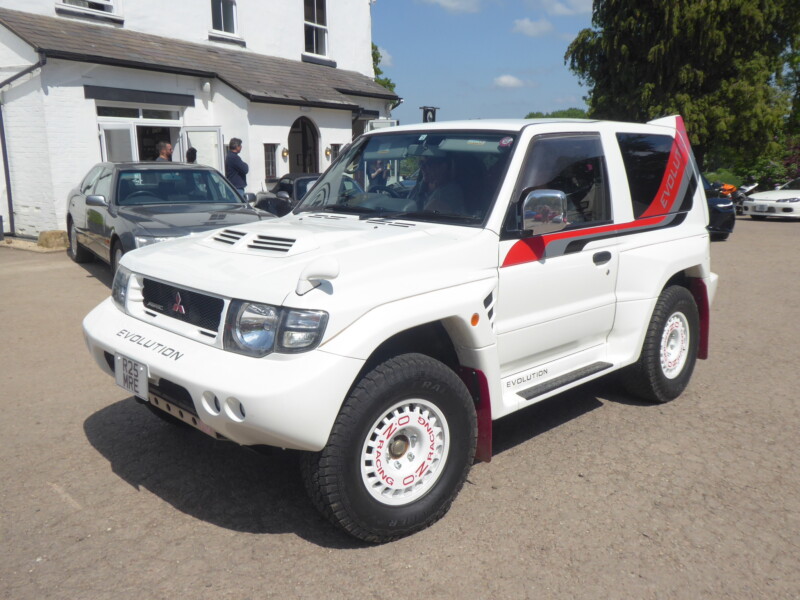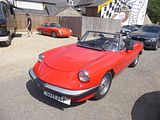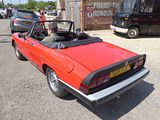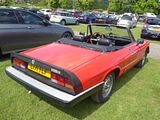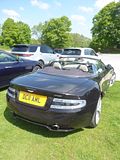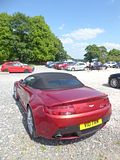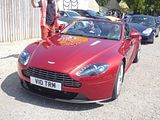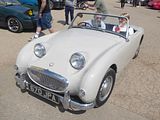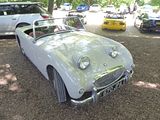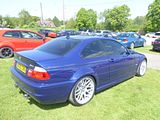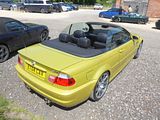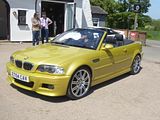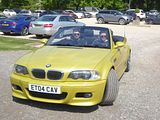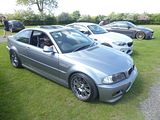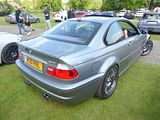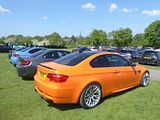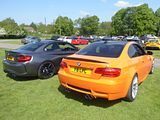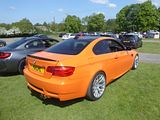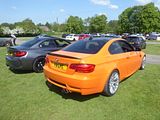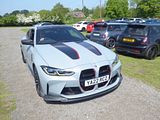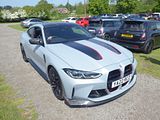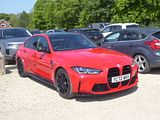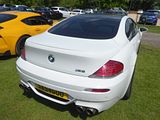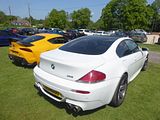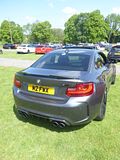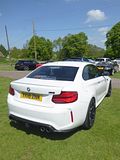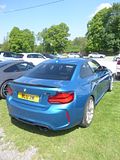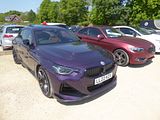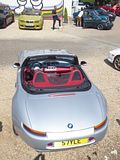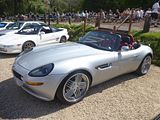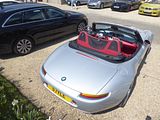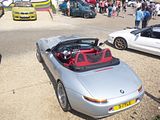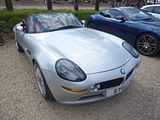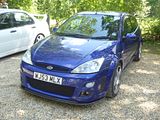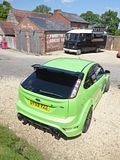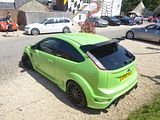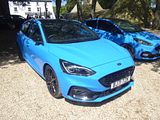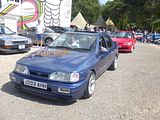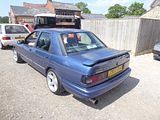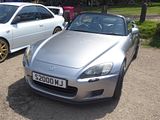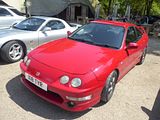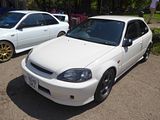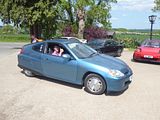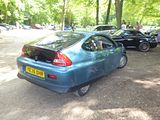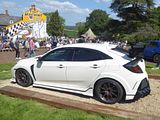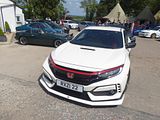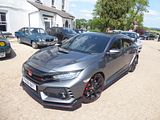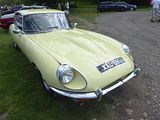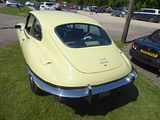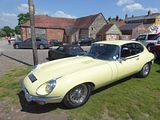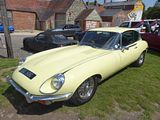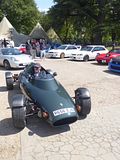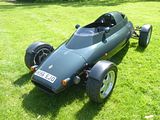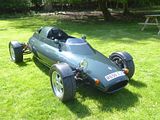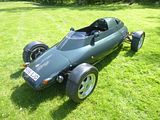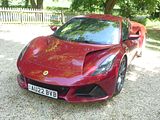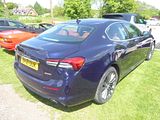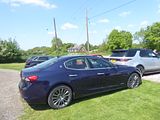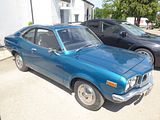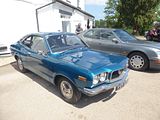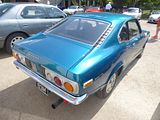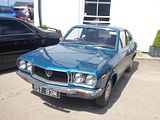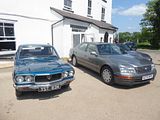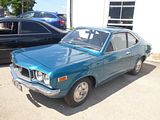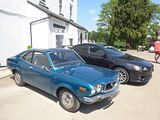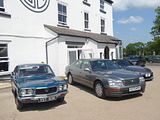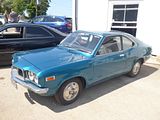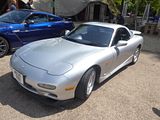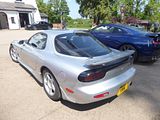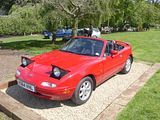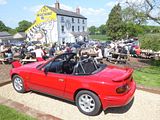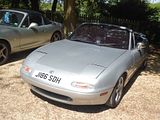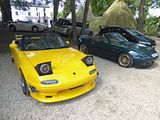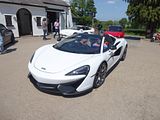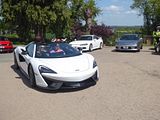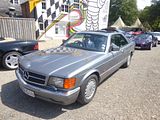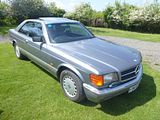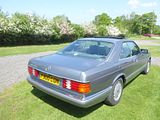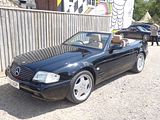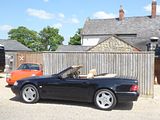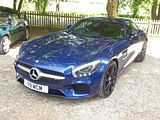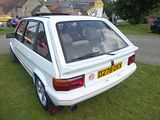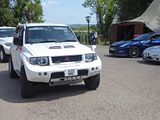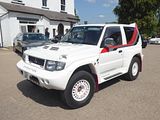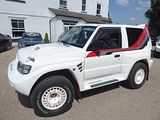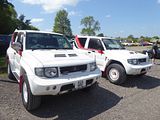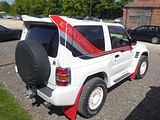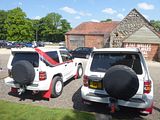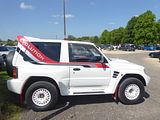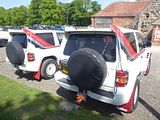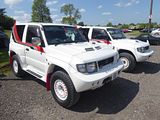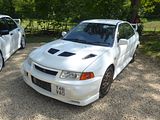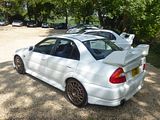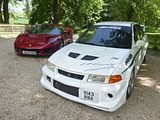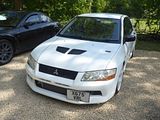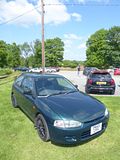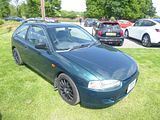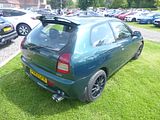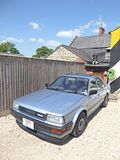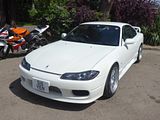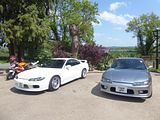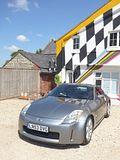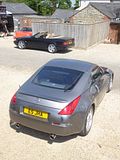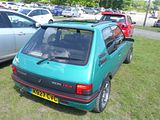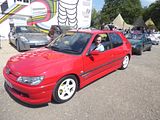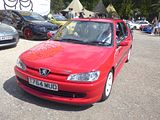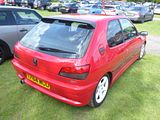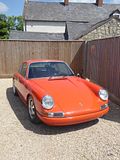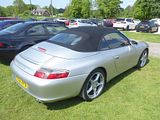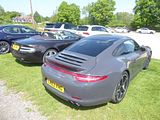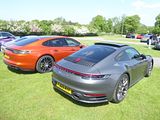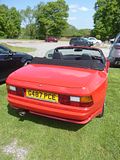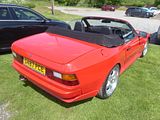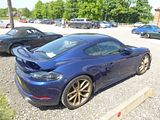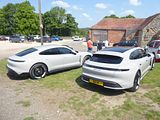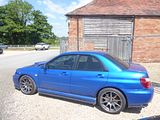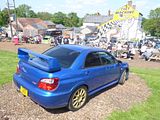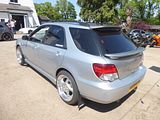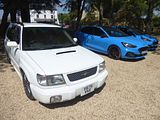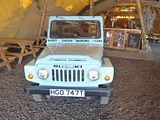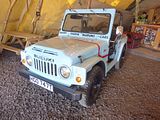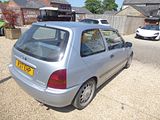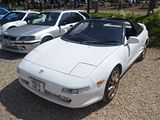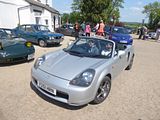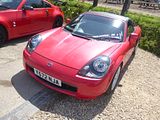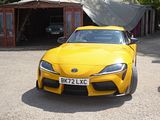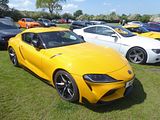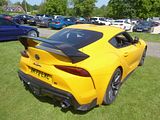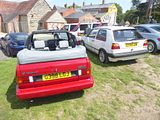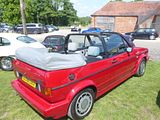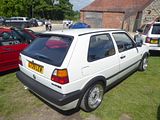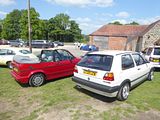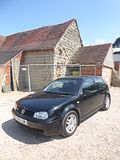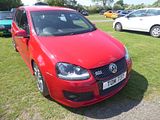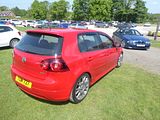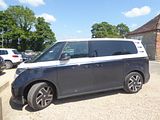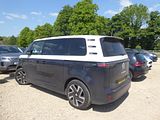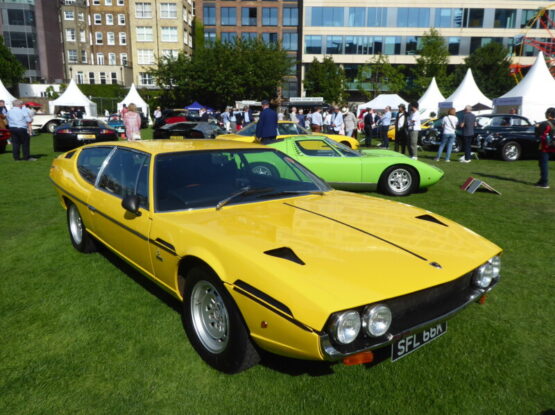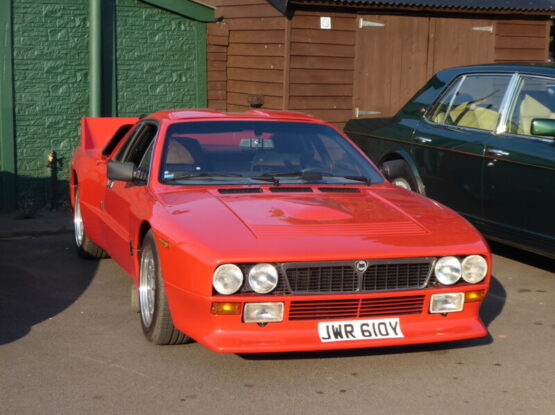Once again, I had been in the Coventry area on a Friday evening, charging around a squash court, and rather than needing to head home at some point after so doing, my diary called for me to head west over to Shropshire for an event at RAF Cosford on the Sunday, so it made sense to find things to occupy me on the Saturday. Caffeine & Machine was an obvious choice for the middle part of the day, and thankfully, when I got around to booking, tickets were still available. When doing so, I did notice that there was a Japanese theme to this particular weekend, and I am well aware that this can mean a lot of very heavily modified recent Japanese performance cars are likely to show up, few of which are really in line with my tastes. Nevertheless, I decided to give it a go. And of course, as is usually the case at this iconic venue, although a theme can be quite evident, it is never allowed to effect a complete take-over so whilst there were all manner of Japanese cars on site, some closer to the way they left the factory than others, there were plenty of cars from other nations here as well, so there was lots of variety. No sooner had I parked up then I heard my name being called and I looked over to find a group of former Abarth owners, including Steven Brownsea and Paul Connolly (now with M BMWs) as well as Stef AB, a renowned YouTuber and also former Abarth owner. Stef had brought a group of people up here earlier in the day and in fact was about to depart, needing to get home, but I was able to point the camera at the BMW M4 CSL he had borrowed before he did so. After having a good chat with the others, I then watched as they headed off and set about meandering around the site to get a good look at what else was parked up. The new process where everyone gets a rolling 3 hour ticket means that there are almost constant comings and goings, so there was plenty to keep me entertained until late in the afternoon. Here is what I saw:
ALFA ROMEO
The Series 3 Spider was previewed in North America for the 1982 model year with the introduction of 2.0 litre Bosch electronic fuel injection to replace the SPICA mechanical injection. The Spider underwent a major styling revamp in 1983, which saw the introduction of black rubber front and rear bumpers. The front bumper incorporated the grille and a small soft rubber spoiler was added to the trunk lid. The change altered the exterior appearance of the car considerably and was not universally praised by enthusiasts. Various other minor mechanical and aesthetic modifications were also made, and the 1600 car (never available in North America) dropped the “Junior” name. The Quadrifoglio Verde (Green Cloverleaf) model was introduced in 1986, with many aesthetic tweaks, including sideskirts, mirrors, new front and rear spoilers, hard rubber boot mounted spoilers with integral 3rd stoplight, unique 15″ alloys and optional removable hardtop. Different interior trim included blood red carpets and grey leather seats with red stitching. The QV was offered in only 3 colours: red, silver and black. It was otherwise mechanically identical to the standard Spider Veloce model, with a 1962 cc double overhead cam, four-cylinder engine (twin two-barrel carburettors in Europe; North American models retained the Bosch L-Jetronic fuel injection introduced for the 1982 model year except that the VVT mechanism was now L-Jet activated) and five-speed manual transmission. The interior was revised with a new centre console, lower dash panels (to meet U.S. regulations) and a single monopod gauge cluster (with electronic gauges). For the North American market a model dubbed the Graduate was added in tribute to the car’s famous appearance in the 1967 film, The Graduate, starring Dustin Hoffman. The Graduate was intended as a less expensive “entry-level” Alfa. While it had the same engine and transmission as the Quadrifoglio and Veloce, it lacked the alloy wheels and luxury features of the other two models. The Graduate model had manual windows, basic vinyl seats, a vinyl top, and steel wheels as standard. Air conditioning and a dealer-installed radio were the only options. It first appeared in 1985 in North America and continued until 1990. Minor changes occurred from 1986 to 89, including new paint colours, a centre high mount stop lamp midway through 1986 for North American models, a move away from the fade-prone brown carpet and new turn signal levers. Some 1988 models featured automatic seatbelts that extended from a large device between the front seats.
ASTON MARTIN
Follow on to the DB7 was the DB9 (there has never been a car called DB8 – supposedly because people might have assumed this meant a V8 engine), and there was a nice example here. The Aston Martin DB9, designed by Marek Reichmann and Hendrik Fisker, was first shown by Aston Martin at the 2003 Frankfurt Auto Show, in coupe form. It was widely praised for the beauty of its lines. This was the first model to be built at Aston Martin’s Gaydon facility. It was built on the VH platform, which would become the basis for all subsequent Aston models. The Aston Martin DB9 was initially launched equipped with a 6.0 litre V12 engine, originally taken from the V12 Vanquish. The engine produced 420 lbf·ft of torque at 5,000 rpm and a maximum power of 444 hp at 6,000 rpm, allowing the DB9 to accelerate from 0 to 60 mph in 4.7 seconds and a top speed of 299 km/h (186 mph). The engine largely sits behind the front-axle line to improve weight distribution. Changes to the engine for the 2013 model year increased the power to 503 hp and torque to 457 lb-ft, decreasing the 0 to 60 mph time to 4.50 seconds and with a new top speed is 295 km/h (183 mph). The DB9 was available with either a six-speed conventional manual gearbox from Graziano or a six-speed ZF automatic gearbox featuring paddle-operated semi-automatic mode. The gearbox is rear-mounted and is driven by a carbon-fibre tail shaft inside a cast aluminium torque tube. The DB9 was the first Aston Martin model to be designed and developed on Ford’s aluminium VH (vertical/horizontal) platform. The body structure is composed of aluminium and composites melded together by mechanically fixed self-piercing rivets and robotic assisted adhesive bonding techniques. The bonded aluminium structure is claimed to possess more than double the torsional rigidity of its predecessor’s, despite being 25 percent lighter. The DB9 also contains anti-roll bars and double wishbone suspension, supported by coil springs. To keep the back-end in control under heavy acceleration or braking, the rear suspension has additional anti-squat and anti-lift technology. Later versions of the car also features three modes for the tuning: normal, for every-day use, sport, for more precise movement at the cost of ride comfort, and track, which furthers the effects of the sport setting. The Aston Martin DB9 Volante, the convertible version of the DB9 coupe, followed a few months later. The chassis, though stiffer, uses the same base VH platform. To protect occupants from rollovers, the Volante has strengthened windscreen pillars and added two pop-up hoops behind the rear seats. The hoops cannot be disabled and will break the car’s rear window if deployed. In an effort to improve the Volante’s ride while cruising, Aston Martin have softened the springs and lightened the anti-roll bars in the Volante, leading to a gentler suspension. The retractable roof of the Volante is made of folding fabric and takes 17 seconds to be put up or down. The Volante weighs 59 kilograms (130 pounds) more than the coupe. The coupe and Volante both share the same semi-automatic and automatic gearboxes and engine. The car was limited to 266 km/h (165 mph) to retain the integrity of the roof. Like the coupe, the original Volante has 420 lb·ft of torque at 5,000 rpm and a maximum power of 450 hp at 6,000 rpm. The 0 to 60 mph slowed to 4.9 seconds due to the additional weight. The DB9 was facelifted in July 2008, which mainly amounted to an increase in engine power, to 476 hp and a redesigned centre console. Externally, the DB9 remained virtually unchanged. For the 2013 model year revision, Aston made minor changes to the bodywork by adapting designs from the Virage, including enlarging the recessed headlight clusters with bi-xenon lights and LED daytime strips, widening the front splitter, updating the grille and side heat extractors, updating the LED rear lights with clear lenses and integrating a new rear spoiler with the boot lid. .On newer models, like the coupe’s, the Volante’s horsepower and torque increased to 517 PS (510 hp) and 457 lb·ft respectively. As a finale for the model, a more powerful DB9 was released in 2015, called the DB9 GT. This had 540 bhp and 457 lb-ft of torque at 5500 rpm, giving a 0 to 60mph time of 4.4 seconds and 0 to 100mph in 10.2 seconds, with the standing quarter mile dispatched in 12.8 to 12.9 seconds and a top speed of 183mph. Production of the DB9 ended in 2016 being replaced by its successor, the DB11.
Following the unveiling of the AMV8 Vantage concept car in 2003 at the North American International Auto Show designed by Henrik Fisker, the production version, known as the V8 Vantage was introduced at the Geneva Motor Show in 2005. The two seat, two-door coupé had a bonded aluminium structure for strength and lightness. The 172.5 inch (4.38 m) long car featured a hatchback-style tailgate for practicality, with a large luggage shelf behind the seats. In addition to the coupé, a convertible, known as the V8 Vantage Roadster, was introduced later in that year. The V8 Vantage was initially powered by a 4.3 litre quad-cam 32-valve V8 which produced 380 bhp at 7,300 rpm and 409 Nm (302 lb/ft) at 5,000 rpm. However, models produced after 2008 had a 4.7-litre V8 with 420 bhp and 470 Nm (347 lbft) of torque. Though based loosely on Jaguar’s AJ-V8 engine architecture, this engine was unique to Aston Martin and featured race-style dry-sump lubrication, which enabled it to be mounted low in the chassis for an improved centre of gravity. The cylinder block and heads, crankshaft, connecting rods, pistons, camshafts, inlet and exhaust manifolds, lubrication system and engine management were all designed in house by Aston Martin and the engine was assembled by hand at the AM facility in Cologne, Germany, which also built the V12 engine for the DB9 and Vanquish. The engine was front mid-mounted with a rear-mounted transaxle, giving a 49/51 front/rear weight distribution. Slotted Brembo brakes were also standard. The original V8 Vantage could accelerate from 0 to 60 mph in 4.8 seconds before topping out at 175 mph. In 2008, Aston Martin introduced an aftermarket dealer approved upgrade package for power and handling of the 4.3-litre variants that maintained the warranty with the company. The power upgrade was called the V8 Vantage Power Upgrade, creating a more potent version of the Aston Martin 4.3-litre V8 engine with an increase in peak power of 20 bhp to 400 bhp while peak torque increased by 10 Nm to 420 Nm (310 lb/ft). This consists of the fitting of the following revised components; manifold assembly (painted Crackle Black), valved air box, right and left hand side vacuum hose assemblies, engine bay fuse box link lead (ECU to fuse box), throttle body to manifold gasket, intake manifold gasket, fuel injector to manifold seal and a manifold badge. The V8 Vantage had a retail price of GB£79,000, US$110,000, or €104,000 in 2006, Aston Martin planned to build up to 3,000 per year. Included was a 6-speed manual transmission and leather-upholstery for the seats, dash board, steering-wheel, and shift-knob. A new 6-speed sequential manual transmission, similar to those produced by Ferrari and Lamborghini, called Sportshift was introduced later as an option. An open-topped model was added to the range in 2006 and then in the quest for more power a V12 Vantage joined the range not long after. There were no fewer than 18 different versions of the car produced over its model life
AUDI
Still highly rated more than a decade after production ceased is the B7 generation RS4, seen here in regular Saloon guise. There was no RS4 built on the Audi “B6” platform that served as the basis for the Audi A4 between 2001 and 2005. However, after a long hiatus, the second Audi RS4 quattro (Typ 8E), was built on Audi’s “B7” A4 platform. It was unveiled in February 2005. The RS4 became available to European customers in mid-2006. It was introduced at the 2006 North American International Auto Show in January, and arrived in June 2006 in North America. The B7 RS4 was an almost complete departure from previous Audi “RS” cars, as it was initially available as a four-door five-seat saloon with a five-door five-seat Avant and two-door four-seat Cabriolet versions arriving later. Only the Audi RS6 had taken this similar route (saloon and Avant) before; the previous RS4 and RS2 were available exclusively as Avants. Constructed from fully galvanised steel, the B7 RS4 uses lightweight aluminium for its front wings and bonnet. The saloon version features a drag coefficient (Cd) of 0.31, from a frontal area of 2.17 m2. Like its B5 predecessor, visually, the B7 RS4 differs from its related B7 S4, by having even wider flared front and rear wheel arches, to allow for a wider axle track. Over the B7 A4, it also includes two larger frontal side air intakes (for the two additional side-mounted coolant radiators). The trim on the saloon and roof rails on the estate are chrome as standard but can also be found in black with the addition of the Optic Pack which includes a black front grill, all exterior trim and black roof rails on the estate version. The B7 RS4 also includes an optional adaptive headlights to complement the standard “Xenon Plus” (Bi-Xenon) High Intensity Discharge (HID) headlamps, which swivel around corners in conjunction with steering wheel movements. Also standard are daytime running lights (DRLs), found within the main headlamp housings, identical to its related B7 A4 and S4, and use a conventional tungsten filament bulb. An acoustic parking system with front and rear sensors is also a standard fitment. Unique carbon fibre interior trims, along with a lap timer within the central Driver Information System (DIS), aluminium pedal caps and footrest, and RS 4 logos complete the look. Kerb weight of the saloon variant starts at 1,650 kg (3,638 lb). The engine of the B7 RS4 is based on the existing all-alloy 4,163 cc V8 from the B6 S4, and shares many parts, and Fuel Stratified Injection, with the 4.2 FSI V8 engine in the Q7. The engine includes new cylinder block construction, and is a highly reworked, high-revving variant (redline at 8,000 rpm; rev limit of 8,250 rpm). The same engine base was used for the Audi R8 when Audi wanted to build their first supercar. However, the camshaft drive system was moved to the front of the block for the mid-engine R8. Audi factory numbers indicate that the B7 RS4 saloon can accelerate from 0 to 100 km/h (0 to 62 mph) in 4.8 seconds, and arrive at 0 to 200 km/h (0 to 124 mph) in 16.6 seconds. Top speed for all variants is “officially” electronically limited to 250 km/h (155.3 mph), though some owners reported that the speed limiter is rather “liberal”, conforming to the pattern of previous Audi “RS” cars, with genuine top speeds of 270 km/h (168 mph) being recorded. The production run of the B7 RS 4 was 2006 to 2008 inclusive. Approximately 10,000 B7 RS4s were built, of which around 2,000 went to the USA.
AUSTIN HEALEY
Known officially as the Sprite, it was announced to the press in Monte Carlo by the British Motor Corporation on 20 May 1958, just before that year’s Monaco Grand Prix. It was intended to be a low-cost model that “a chap could keep in his bike shed”, yet be the successor to the sporting versions of the pre-war Austin Seven. The Sprite was designed by the Donald Healey Motor Company, with production being undertaken at the MG factory at Abingdon. It first went on sale at a price of £669, using a tuned version of the Austin A-Series engine and as many other components from existing cars as possible to keep costs down. It was produced for a little over 3 years before being replaced by a Mark 2 version, which was then joined by a badge-engineered MG version, the Midget, reviving a model name used by MG from the late 1920s through to the mid 1950s. Enthusiasts often refer to Sprites and the later Midgets collectively as “Spridgets.” The first Sprite quickly became affectionately known as the “frogeye” in the UK and the “bugeye” in the US, because its headlights were prominently mounted on top of the bonnet, inboard of the front wings. The car’s designers had intended that the headlights could be retracted, with the lenses facing skyward when not in use; a similar arrangement was used many years later on the Porsche 928. But cost cutting by BMC led to the flip-up mechanism being deleted, therefore the headlights were simply fixed in a permanently upright position, giving the car its most distinctive feature. The body was styled by Gerry Coker, with subsequent alterations by Les Ireland following Coker’s emigration to the US in 1957. The car’s distinctive frontal styling bore a strong resemblance to the defunct American 1951 Crosley Super Sport. The problem of providing a rigid structure to an open-topped sports car was resolved by Barry Bilbie, Healey’s chassis designer, who adapted the idea provided by the Jaguar D-type, with rear suspension forces routed through the bodyshell’s floor pan. The Sprite’s chassis design was the world’s first volume-production sports car to use unitary construction, where the sheet metal body panels (apart from the bonnet) take many of the structural stresses. The original metal gauge (thickness of steel) of the rear structure specified by Bilbie was reduced by the Austin Design Office during prototype build, however during testing at MIRA (Motor Industry Research Association) distortion and deformation of the rear structure occurred and the original specification was reinstated. The two front chassis legs projecting forward from the passenger compartment mean the shell is not a full monocoque. The front sheet-metal assembly, including the bonnet (hood) and wings, was a one-piece unit, hinged from the back, that swung up to allow access to the engine compartment. The 43 bhp, 948 cc OHV engine (coded 9CC) was derived from the Austin A35 and Morris Minor 1000 models, also BMC products, but upgraded with twin 11⁄8 inch SU carburettors which gave it 43 hp at 5200 rpm and 52 lb/ft at 3300 rpm. When tested by “The Motor” magazine in 1958. It had a top speed of 82.9 mph and could accelerate from 0-60 mph in 20.5 seconds. Fuel consumption of 43 mpg was recorded. The rack and pinion steering was derived from the Morris Minor 1000 and the front suspension from the Austin A35. The front suspension was a coil spring and wishbone arrangement, with the arm of the Armstrong lever shock absorber serving as the top suspension link. The rear axle was both located and sprung by quarter-elliptic leaf springs, again with lever-arm shock absorbers and top links. There were no exterior door handles; the driver and passenger were required to reach inside to open the door. There was also no boot lid, owing to the need to retain as much structural integrity as possible, and access to the spare wheel and luggage compartment was achieved by tilting the seat-backs forward and reaching under the rear deck, a process likened to potholing by many owners, but which resulted in a large space available to store soft baggage. The BMC Competition Department entered Austin Healey Sprites in major international races and rallies, their first major success coming when John Sprinzel and Willy Cave won their class on the 1958 Alpine Rally. Private competitors also competed with much success in Sprites. Because of its affordability and practicality, the Austin Healey Sprite was developed into a formidable competition car, assuming many variants by John Sprinzel, Speedwell and WSM. The Sebring Sprite became the most iconic of the racing breed of Austin Healey Sprites. Many owners use their Austin Healey Sprites in competition today, fifty years after its introduction. 48,987 “frogeye” Sprites were made and the car remains popular to this day.
BMW
The M3 version of the E46 3 Series was produced in coupé and convertible body styles. The E46 M3 is powered by the S54 straight-six engine and has a 0-100 km/h (62 mph) acceleration time of 5.1 seconds for the coupe, with either the manual or SMG-II transmission. The skid pad cornering results are 0.89 g for the coupe and 0.81 g for the convertible. The top speed is electronically limited to 250 km/h (155 mph). The available transmissions were a Getrag 420G 6-speed manual transmission or a SMG-II 6-speed automated manual transmission, which was based on the Getrag 420G. The SMG-II used an electrohydraulically actuated clutch and gearshifts could be selected via the gear knob or paddles mounted on the steering wheel. The SMG-II was praised for its fast shift times and racetrack performance, but some people found its shifts to be delayed and lurching in stop-start traffic. In 2005, a special edition was introduced which used several parts from the CSL. This model was called the M3 Competition Package (ZCP) in the United States and mainland Europe, and the M3 CS in the United Kingdom. Compared to the regular M3, the Competition Package includes: 19-inch BBS alloy wheels- 19″x 8″ at the front and 19″x 9.5″ at the rear; Stiffer springs (which were carried over to the regular M3 from 12/04); Faster ratio steering rack of 14.5:1 (compared with the regular M3’s ratio of 15.4:1) as per the CSL; Steering wheel from the CSL; M-track mode for the electronic stability control, as per the CSL; The CSL’s larger front brake discs (but with the regular M3 front calipers) and rear brake calipers with larger pistons; Alcantara steering wheel and handbrake covers; The engine, gearbox and other drivetrain components are the same as the standard M3. Total production of the E46 M3 was 56,133 coupes and 29,633 convertibles. The cars were assembled at the BMW Regensburg factory in Germany and production was from September 2000 until August 2006, production totalled 85,766.
The M3 model of the E90/E92/E93 3 Series range was powered by the BMW S65 V8 engine and was produced in sedan, convertible and coupé body styles. The E9x is the first and only standard production M3 powered by a V8 engine as its successor would revert to using a straight 6 engine. In the standard M3, the S65 engine rated at 420 PS (414 bhp) at 8,300 rpm and 400 Nm (295 lb/ft) at 3,900 rpm. Initially, the M3 was produced with a 6-speed manual transmission. In April 2008, the E90/E92/E93 M3 became the first BMW to be available with a dual-clutch transmission when the 7-speed Getrag “M-DCT” transmission was introduced as an option. The official 0 to 100 km/h (62 mph) acceleration times for the coupé and sedan are 4.6 seconds with the DCT transmission (4.8 seconds with the manual transmission) and 5.1 seconds for the convertible. The E90 and E92 versions received many positive reviews, including “the greatest all-around car in the world”, “the finest car on the market, period” and “the best, most complete car in the world”. The first body style to be introduced was the coupé, which was previewed at the 2007 Geneva Motor Show and introduced in production form at the 2007 Frankfurt Motor Show on 12 September. The coupé version uses a carbon fibre roof to reduce weight and lower the centre of gravity. In 2010, the coupé and convertible versions received a minor facelift, which included revised LED tail-lights and minor interior trim pieces but it did not get the updated headlights from the regular series. The E93 convertible version was introduced shortly after the coupé and uses a power retractable hardtop. The leather seats in the convertible version are treated with a coating to reflect sunlight, in order to reduce their tendency to become uncomfortably hot with the top down. A sedan version was introduced in 2008 and was the second (along with the E36) M3 by generation to be produced in a 4-door body style. The sedan has the same drivetrain and similar external styling as the coupé, however the lack of a carbon fibre roof contributes to a weight increase of 10 kg (22 lb) compared to an identically equipped coupé. The official kerb weights for the 2008 European-specification models (with manual transmission) are 1,580 kg (3,483 lb) for the coupé, 1,605 kg (3,538 lb) for the sedan and 1,810 kg (3,990 lb) for the convertible. Total production of the E9x M3 was 40,092 coupés, 16,219 convertibles and 9,674 sedans. Production of sedan models finished in 2011, with coupés remaining in production until July 5, 2013.
The M3 version of the F30 3 Series was designated the F80 and was produced from 2014 to 2018. The F80 M3 was powered by the BMW S55 twin-turbocharged straight-six engine, therefore being the first turbocharged M3 model. Despite the smaller displacement than the V8 engine used by the previous generation of M3, the switch from naturally aspirated engines to turbocharging resulted in peak power being increased from 414 to 425 bhp, and peak torque being increased from 400 to 550 Nm (295 to 406 lb/ft). The official 0–60 mph acceleration times are 3.9 seconds with the M-DCT transmission and 4.1 seconds with the manual transmission. Top speed is limited to 250 km/h (155 mph) but an optional M Driver’s package raises this to 280 km/h (174 mph). The kerb weight is 1,621 kg (3,574 lb). The F80 M3 was unveiled, alongside the F82 M4 (its coupé counterpart), at the 2014 North American International Auto Show. The two-door M3 had been renamed BMW M4 – in line with the new BMW 4 Series range. 2016, a Competition Package became available for the M3 and M4. Changes included an increase in power to 444 bhp, revised tuning of the electronic differential and the electronic stability control (“DSC”), suspension upgrades and new front seats. The official 0–100 km/h (62 mph) time was 4.0 seconds with the dual-clutch transmission. The F80 generation of M3 was produced only as a saloon, following the company’s plans to split off the 4 Series coupé and convertible from the 3 Series. To minimise weight, the roof is made of carbon fibre and the bonnet and front quarter panels are made from aluminium. The F80 M3’s design was updated in (summer) 2015 for the 2016 model year and in (march) 2017 for the 2018 model year. In the former, the taillights were given LEDs, and in the latter, the headlights were restyled and also given newer and more angular LEDs. Production ceased in October 2018, due to the extensive changes required to meet the WLTP emissions regulations. However, the M4 model remained in production.
This is the recently available and very expensive M4 CSL. At the 2017 Frankfurt Auto Show, head of BMW’s M division Frank Van Meel announced that the CSL nameplate would be making a return, replacing the GTS in the performance model monikers. On May 4 of 2022, BMW announced that the M4 CSL would debut at the 2022 Concorso d’Eleganza Villa d’Este. Changes include significant weight reduction of around 200 lb (91 kg) (hence the CSL name, which stands for Competition Sport Light), a large front carbon fibre front splitter, a ducktail rear spoiler, more horsepower, 543 bhp. Fast forward to May 2022, BMW M revealed the G82 M4 CSL. The latest M4 is now lighter and more powerful than its standard M4 counterpart. Only 1,000 units will be made.
The BMW E34 is the third generation of the BMW 5 Series, which was produced from November 2, 1987 until 1996. Initially launched as a sedan in January 1988, the E34 also saw a “Touring” station wagon (estate) body style added in September 1992, a first for the 5 Series. BMW replaced the E34 with the E39 5 Series in December 1995, although E34 Touring models remained in production until June 1996. Development ran from July 1981 to early 1987, with the initial design proposal penned by Ercole Spada in 1982. Under the guidance of chief designer Claus Luthe, BMW based much of the design on the E32 7 Series. Following Spada’s departure from BMW and styling approval in 1983, J Mays finalized the design for production in mid-1985. Special attention was paid to aerodynamics, with the E34 basic sedan having a drag coefficient of 0.30. Series production began in November 1987.In December 1987, the E34 sedan was unveiled to the global press. The base model, available only in Europe, was the petrol-powered four-cylinder 518i. Only available with a 5-speed manual transmission, a total of 53,248 cars were produced. The next petrol model up was the six-cylinder 520i, which began production in January 1988. It was initially powered by the BMW M20 single overhead camshaft engine, which was replaced by the BMW M50 double overhead camshaft engine in 1990. The 520i was the second most popular E34 model globally, with 426,971 units produced. The 525i was the most popular E34 model globally with 434,549 units produced. As per the 520i, the 525i initially used the M20 engine, which was replaced by the M50 engine in 1990. A rare E34 model is the petrol-powered six-cylinder 525iX, of which only 9,366 cars were produced. The 525iX was the first all-wheel drive 5 Series, and the only all-wheel drive model in the E34 range. It was powered by the BMW M50 engine and was the first 5 Series to use a rack and pinion steering system. There are two versions of the E34 530i: an inline-six model produced from 1988 to 1990, and a V8 model produced from 1993 to 1995. The earlier model was one of the last applications of the BMW M30 inline-six engine. The V8 version, which replaced the six-cylinder 535i in the lineup, was powered by the new BMW M60 V8 engine and was available with a 5-speed manual or 5-speed automatic transmission. Initially, the V8 models were differentiated from other models by the wide grill; in 1994 the wide grill became available on other models. Between the two versions of the 530i, a total of 57,570 cars were produced. The highest six-cylinder model (except for the M5) was the 535i. Despite the ‘535i’ model designation and ‘3.5’ casting on the intake manifold, the BMW M30 engine found in the E34 535i actually has a displacement of 3.4 litres. A total of 97,679 cars were produced, including the Alpina B10 (BiTurbo, 3.5) models. The 535i was replaced by the V8-engined 530i and 540i models in 1993. In 1993, the 540i model was added to the top of the 5 Series lineup, powered by the BMW M60 V8 engine and available in both sedan and wagon body styles (the latter not in US). Transmission options were a 6-speed manual or a 5-speed automatic. A total of 26,485 units were produced. Initially, the V8 models were differentiated from other models by the wider grilles. In 1994 the wide grilles became available on other models as well. The first diesel model was the 524td, which was introduced in 1988. This model was replaced by the 525tds in 1991, and a lower-specification 525td was introduced in 1993. All diesel models were powered by turbocharged inline-six engines. Introduced in September 1988 and produced until August 1995, the E34 M5 was produced in both sedan and station wagon (‘Touring’) body styles, the latter being the first M5 to be available as a wagon. The E34 M5 is powered by the BMW S38 inline-six engine, originally with a displacement of 3.6 L and an output of 311 bhp, later upgraded to a 3.8 L engine rated at 335 bhp. This 3.8 litre version of the M5 was first seen by the public at the 1991 Frankfurt Motor Show, where the E34 M5 Touring also saw its debut. In its last year of production for the M5, the transmission was upgraded from a 5-speed manual to the Getrag 420G 6-speed manual (which was also used by the 540i model). The whole range was replaced by the E39 series in 1996.
Showing the evolution of the 5 series through 7 generations was this example of the latest M5
The second generation of the BMW 6 Series consists of the BMW E63 (coupe version) and BMW E64 (convertible version) grand tourers. The E63/E64 generation was produced by BMW from 2003 to 2010 and is often collectively referred to as the E63. The E63 uses a shortened version of the E60 5 Series chassis and subsequently shares many features. The car initially drew criticism, due to its controversial styling and complicated iDrive system. The M6 model was introduced in 2005 in coupé and convertible body styles. It is powered by the S85 V10 engine shared with the E60 M5, and most M6s were produced with a 7-speed automated manual transmission (“SMG III”). In March 2011, the BMW 6 Series (F06/F12/F13) began production as the successor to the E63. The M6 version was initially introduced as a coupé at the 2005 Geneva International Motor Show, and later in convertible form at the British International Motor Show in 2006. The M6 is powered by the 5.0-litre naturally aspirated S85 V10 shared with the E60 M5, generating 500 bhp at 7,750 rpm and 520 Nm (384 lb/ft) at 6,100 rpm. The majority of the cars were produced with a 7-speed automated manual transmission (“SMG III”), however a 6-speed manual transmission was also available in the United States. The M6 coupé has a carbon fibre roof in order to reduce weight and for a lower centre of gravity. Additional features included: sports seats, larger front and rear brakes, an M-performance instrument cluster, a carbon-fibre roof (coupé only), and an optional M head-up Display. The car also has quad exhaust-pipes and larger, more aerodynamic air intakes. A total of 9,087 coupés and 5,065 convertibles were built; amounting to 14,152 cars.
The M2 was first revealed in Need for Speed: No Limits on November 2015, before later premiering at the North American International Auto Show in January 2016. Production commenced in October 2015 and is only available as a rear-wheel drive coupé. The M2 is powered by the turbocharged 3.0-litre N55B30T0 straight-six engine producing 365 bhp at 6,500 rpm and 465 Nm (343 lb/ft) between 1,450–4,750 rpm, while an overboost function temporarily increases torque to 500 N⋅m (369 lb⋅ft). The M2 features pistons from the F80 M3 and F82 M4, and has lighter aluminium front and rear suspension components resulting in a 5 kg (11 lb) weight reduction. The M2 is available with a 6-speed manual or with a 7-speed dual-clutch transmission which features a ‘Smokey Burnout’ mode. 0-100 km/h acceleration times are 4.5 seconds manual transmission models and 4.3 seconds for models equipped with the 7-speed dual clutch transmission. Top speed is limited to 250 km/h (155 mph) but can be extended to 270 km/h (168 mph) with the optional M Driver’s package. The M2 Competition was introduced at the 2018 Beijing Auto Show and succeeded the standard M2 Coupé. Production began in July 2018. The M2 Competition uses the high performance S55 engine which is a variant of the 3.0-litre twin turbocharged straight six engine found in the F80 M3 and F82 M4. The engine features a redesigned oil supply system and modified cooling system from the BMW M4 with the Competition Package, and also features a gasoline particulate filter in certain European Union countries to reduce emissions. Compared to the standard M2, the S55 produces an additional 30 kW (40 hp) and 85 Nm (63 lb/ft), resulting in a larger and more sustained power output of 405 bhp between 5,370–7,200 rpm, and 550 Nm (406 lb/ft) at 2,350–5,230 rpm. The 0-100 km/h acceleration time is 4.4 seconds for six-speed manual transmission models, and 4.2 seconds for models with the 7-speed dual clutch transmission. Top speed is electronically limited to 250 km/h (155 mph), but the M Driver’s package can extend the limit to 280 km/h (174 mph) which is 10 km/h (6 mph) further than in the M2. The M2 Competition also has a carbon-fibre reinforced plastic strut bar, enlarged kidney grilles, and larger brake discs of 400 mm (15.7 in) in the front axle and 380 mm (15.0 in) in the rear axle. Because of the new engine and cooling system, the M2 Competition is 55 kg (121 lb) heavier than the standard M2 at 1,550 kg (3,417 lb) for manual transmission models and 1,575 kg (3,472 lb) for dual-clutch transmission models. Production recently ended in anticipation of the next generation car.
That next generation M2 was also here.
Originally presented as a concept, the Z07, a styling exercise intended to evoke and celebrate the 1956-’59 BMW 507 and to celebrate the millennium change, the car was a sensation at the ’97 Tokyo Auto Show and its overwhelming popularity spurred BMW’s decision to produce a limited production model. Fortunately, the Z07 had been designed with production in mind. As a result, practical and regulatory considerations necessitated very few changes for the production model. Nevertheless, the windscreen of the Z8 was extended upward, and a larger front airdam was fitted. Both changes were implemented to provide aerodynamic stability and a reasonably placid cockpit environment. The four-spoke steering wheel of the concept car was replaced by a three spoke design. The hardtop was changed from a double-bubble form with a tapering faring to a single dome with a truncated convex backside. The concept’s exotic driver’s side helmet fairing was eliminated to allow easy operation of the power soft top. Despite these changes, the Z8 remained extremely faithful to the concept car. The side-mounted indicators were integrated into the side vents in a fashion that rendered them invisible until activated. The vintage simplicity of the interior was preserved by hiding the modern equipment under retracting panels. Complex compound curves were preserved through the use of an expensive MIG-welded aluminium space frame. The Z8 even retained the concept’s five-spoke wheel design, albeit without the race-style centre lug nut. The Z8’s spaceframe was produced in the Dingolfing Plant and the car hand-finished in Munich. It had an all-aluminium chassis and body and used a 4941 cc 32-valve V8, that developed 400 hp and 370 lb·ft (500 N·m) torque. This engine, known internally as the S62, was built by the BMW Motorsport subsidiary and was shared with the E39 M5. The engine was located behind the front axle in order to provide the car with 50/50 weight distribution. The factory claimed a 0–100 km/h (0–62 mph) time of 4.7 seconds; Although it could outperform a Ferrari 360 Modena in several respects, as with most BMW products, its top speed was electronically limited to 155 mph (250 km/h). The Z8 used neon exterior lighting, the tail lights and indicators are powered by neon tubes that offer quicker activation than standard lightbulbs and expected to last for the life of the vehicle. The Z8’s head and tail lights were done by Vipin Madhani. Every Z8 was shipped with a colour-matching metal hardtop. Unlike many accessory hardtops, which are provided for practical rather than stylistic considerations, the Z8 hardtop was designed from the outset to complement the lines of the roadster. In order to promote the Z8 to collectors and reinforce media speculation about the Z8’s “instant classic” potential, BMW promised that a 50-year stockpile of spare parts would be maintained in order to support the Z8 fleet. Due to the limited volume of Z8 production, all elements of the car were constructed or finished by hand, thereby compounding the importance of ongoing manufacturer support for the type. The price point and production process allowed BMW to offer custom options to interested buyers. A significant number of Z8s with non-standard paint and interior treatments were produced over the course of the four-year production run by BMW Individual. 5,703 Z8s were built.
FORD
Ford did not make the same mistake with the Focus as they had with its predecessor, so even the ordinary models were good to drive. There was a long wait for a truly sporting flagship, but when it arrived, in late 2002, the Focus RS proved to be rather special. Originally it was to be released as the Racing Focus, however after the poor selling Racing Puma, Ford decided to revive the RS badge. The car was largely built on its own assembly line in Ford’s Saarlouis plant, with some additional specialist off-line assembly performed by the ACÜ group at Überhern. The RS was offered all over Europe, with production limited to 4501 units. 2147 of these were sold in the United Kingdom, by far its largest of the 21 markets where it was available. The development of the Focus RS was undertaken by a mixed team of mainstream Ford engineers (not SVE or the TeamRS group which replaced it later on) and Tickford Engineering in Milton Keynes, United Kingdom. More bespoke than the prior Focus ST170, the Focus RS upgraded or replaced 70% of the standard Focus mechanicals. The turbocharged straight-4 engine produced a minimum of 212 bhp and 310 N·m (229 lb·ft) of torque, which was then mated to the 5-speed MTX-75 and not the Getrag transmission used in the ST 170. Mechanically, most notably, the car incorporated a Quaife automatic torque biasing differential to improve traction from the front-wheel drive setup. The steering used a similar quick-ratio rack as the ST170 while the brakes used fixed-caliper, four-piston Brembo units with 12.8 in discs at the front and single-piston floating calipers and 11.0 in discs at the back. Wheels were 18″ alloys specially developed by OZ Racing. The engine was heavily modified with forged aluminium pistons, hardened valve seats, sodium-filled exhaust valves, stainless steel exhaust system. The forced induction system comprised a Garrett turbocharger with a water-cooled charge air cooler and an electric water pump. To transmit the higher torque an upgraded AP clutch was used. It could generate a steady 0.98G in lateral acceleration due to racing parts such as Sachs dampers, lightweight O.Z Alloy Wheels and a Quaife ATB Differential. It would also allow 1.0G of braking force due to the standard Brembo braking system. The Focus RS was available in one metallic colour, Imperial Blue. The body looked similar to the standard Focus or to the ST170, although the RS featured unique front and rear bumper assemblies required for the wider wheel arches which accommodated the 65 mm (2.6 in) wider front track. Internally, the theme is blue and black with sections of blue leather trim on the door trim panels, the steering wheel and the Sparco seats which were trimmed in blue/black leather and Alcantara. A green starter button starts the engine. The instruments have a blue background and in place of the coolant temperature gauge, the RS was equipped with a boost pressure indicator (up to 1.5 bar). The gear lever knob, handbrake lever, and pedals were all custom made by Sparco. All-around performance was roughly equal or better to its other competitors, including hatchbacks such as the Honda Civic Type-R and some four-wheel drive cars in the same price field. Power was a diminished priority and the handling on a track, courtesy of the front differential, was considered by most observers to be its strongest characteristic. In a Top Gear review, Jeremy Clarkson noted that “it lacks the straightforward oomph of a Subaru Impreza. […] The reason it was quick round our track is simple: this car handles like it’s in a cartoon.” Clarkson and other motor journalists also commented on the car’s torque steer on bumpy British roads. Well preserved examples – and that’s not all of them, by any means, now – are worth decent money and will likely increase in value over time.
There was an even longer wait for an RS version of the second generation Focus. The regular cars were released in late 2004. An ST version followed very quickly, and for a long time, Ford maintained that was the only sporty Focus there was going to be. Finally, on December 17, 2007 Ford of Europe confirmed that a Mk 2 Focus RS would be launched in 2009, with a concept version due in mid-2008. with an upgraded Duratec ST engine with 305PS Duratec RS, gearbox, suspension, and LSD. In 2008, Ford revealed the new Focus RS in “concept” form at the British International Motor Show. Contrary to numerous rumours and speculation, the RS was announced by Ford to have a conventional FWD layout. The Duratec RS engine was upgraded to produce 301 bhp and 325 lb/ft of torque. 0 to 100 km/h (62 mph) acceleration was quoted to be under 6 seconds. The RS used a modified Volvo -engineered 2,522cc five-cylinder engine found in the Focus ST. A larger Borg Warner K16 turbo now delivers up to 20.3-psi of boost. A new air-to-air intercooler has been developed as a complement, while the forged crankshaft, silicon-aluminium pistons, graphite-coated cylinder bores, 8.5:1 compression ratio and variable valve timing also up the power output. The car remained front wheel drive, but to reduce torque steer used a Quaife Automatic Torque Biasing LSD, and a specially designed MacPherson strut suspension at the front called RevoKnuckle, which provided a lower scrub radius and kingpin offset than traditional designs while avoiding the increased weight and complexity of double wishbone and multi-link suspension setups. Ford UK claim: “It’s as close as you’ll come to driving a full-spec rally car (Ford Focus RS WRC). The production car was finally unveiled on 5 January 2009. It looked very distinctive, as at the rear a large venturi tunnel and a dramatic rear spoiler created a purposeful look. It was available in three expressive exterior colours: Ultimate Green, Performance Blue and Frozen White. The ‘Ultimate’ Green was a modern reinterpretation of the classic 1970s Ford Le Mans Green of the Ford Escort RS1600 era.
There has not been an RS version of the fourth generation Focus, despite rumours persisting for a while about such a car, so the sporting top of the range these days is the ST and there was at least one of these here along with a number of other sporting Ford models.
The Sierra RS Cosworth model. a very sporting version of Ford’s upper-medium sized family car, was built by Ford Europe from 1986 to 1992, the result of a Ford Motorsport project with the purpose of producing an outright winner for Group A racing in Europe. The project was defined in the spring of 1983 by Stuart Turner, then recently appointed head of Ford Motorsport in Europe, who had realised right away that Ford was no longer competitive in this area. Turner got in touch with Walter Hayes, at the time the vice-president of public relations at Ford, to get support for the project. Hayes had earlier been the driving force behind the development of the Ford GT40 that won Le Mans in 1966, and the Cosworth DFV engine that brought Ford 154 victories and 12 world championships in Formula One during the 1960s and 1970s. Hayes found the project very appealing and promised his full support. Turner then invited Ken Kohrs, vice-president of development, to visit Ford’s longtime partner, the automotive company Cosworth, where they were presented a project developed on Cosworth’s own initiative, the YAA engine. This was a twin cam, 16-valve engine based on Ford’s own T88 engine block, better known as the Pinto. This prototype proved an almost ideal basis for the engine Turner needed to power his Group A winner. Therefore, an official request for a turbocharged version (designated Cosworth YBB) capable of 180 HP on the street and 300 HP in race trim, was placed. Cosworth answered positively, but they put up two conditions: the engine would produce not less than 204 HP in the street version, and Ford had to accept no fewer than 15,000 engines. Turner’s project would only need about 5,000 engines, but Ford nevertheless accepted the conditions. The extra 10,000 engines would later become one of the reasons Ford also chose to develop a four door, second generation Sierra RS Cosworth. To find a suitable gearbox proved more challenging. The Borg-Warner T5, also used in the Ford Mustang, was chosen, but the higher revving nature of the Sierra caused some problems. Eventually Borg-Warner had to set up a dedicated production line for the gearboxes to be used in the Sierra RS Cosworth. Many of the suspension differences between the standard Sierra and the Cosworth attributed their development to what was learned from racing the turbocharged Jack Roush IMSA Merkur XR4Ti in America and Andy Rouse’s successful campaign of the 1985 British Saloon Car Championship. Much of Ford’s external documentation for customer race preparation indicated “developed for the XR4Ti” when describing parts that were Sierra Cosworth specific. Roush’s suspension and aerodynamics engineering for the IMSA cars was excellent feedback for Ford. Some production parts from the XR4Ti made their way into the Cosworth such as the speedometer with integral boost gauge and the motorsport 909 chassis stiffening plates. In April 1983, Turner’s team decided on the recently launched Sierra as a basis for their project. The Sierra filled the requirements for rear wheel drive and decent aerodynamic drag. A racing version could also help to improve the unfortunate, and somewhat undeserved, reputation that Sierra had earned since the introduction in 1982. Lothar Pinske, responsible for the car’s bodywork, demanded carte blanche when it came to appearance in order to make the car stable at high speed. Experience had shown that the Sierra hatchback body generated significant aerodynamic lift even at relatively moderate speed. After extensive wind tunnel testing and test runs at the Nardò circuit in Italy, a prototype was presented to the project management. This was based on an XR4i body with provisional body modifications in fibreglass and aluminium. The car’s appearance raised little enthusiasm. The large rear wing caused particular reluctance. Pinske insisted however that the modifications were necessary to make the project successful. The rear wing was essential to retain ground contact at 300 km/h, the opening between the headlights was needed to feed air to the intercooler and the wheel arch extensions had to be there to house wheels 10” wide on the racing version. Eventually, the Ford designers agreed to try to make a production version based on the prototype. In 1984, Walter Hayes paid visits to many European Ford dealers in order to survey the sales potential for the Sierra RS Cosworth. A requirement for participation in Group A was that 5,000 cars were built and sold. The feedback was not encouraging. The dealers estimated they could sell approximately 1,500 cars. Hayes did not give up, however, and continued his passionate internal marketing of the project. As prototypes started to emerge, dealers were invited to test drive sessions, and this increased the enthusiasm for the new car. In addition, Ford took some radical measures to reduce the price on the car. As an example, the car was only offered in three exterior colours (black, white and moonstone blue) and one interior colour (grey). There were also just two equipment options: with or without central locking and electric window lifts. The Sierra RS Cosworth was first presented to the public at the Geneva Motor Show in March 1985, with plans to release it for sale in September and closing production of the 5,000 cars in the summer of 1986. In practice, it was launched in July 1986. 5545 were manufactured in total of which 500 were sent to Tickford for conversion to the Sierra three-door RS500 Cosworth. The vehicles were manufactured in right hand drive only, and were made in Ford’s Genk factory in Belgium. Exactly 500 RS500s were produced, all of them RHD for sale in the UK only – the biggest market for this kind of Ford car. It was originally intended that all 500 would be black, but in practice 56 white and 52 moonstone blue cars were produced.To broaden the sales appeal, the second generation model was based on the 4 door Sierra Sapphire body. It was launched in 1988, and was assembled in Genk, Belgium, with the UK-built Ford-Cosworth YBB engine. Cylinder heads on this car were early spec 2wd heads and also the “later” 2wd head which had some improvements which made their way to the 4X4 head. Suspension was essentially the same with some minor changes in geometry to suit a less aggressive driving style and favour ride over handling. Spindles, wheel offset and other changes were responsible for this effect. Approximately 13,140 examples were produced during 1988-1989 and were the most numerous and lightest of all Sierra Cosworth models. Specifically the LHD models which saved weight with a lesser trim level such as manual rear windows and no air conditioning. In the UK, the RHD 1988-1989 Sierra Sapphire RS Cosworth is badged as such with a small “Sapphire” badge on the rear door window trims. All 1988-1989 LHD models are badged and registered as a Sierra RS Cosworth with no Sapphire nomenclature at all. “Sapphire” being viewed as a Ghia trim level that saw power rear windows, air conditioning and other minor options. Enthusiasts of the marque are mindful of this and will describe the LHD cars by their body shell configuration, 3 door or 4 door. As the Sapphire Cosworth was based on a different shell to the original three-door Cosworth, along with its more discreet rear wing, recorded a drag co-efficient of 0.33, it registered slightly better performance figures, with a top speed of 150 mph and 0-60 of 6.1 seconds, compared to the original Cosworth. In January 1990, the third generation Sierra RS Cosworth was launched, this time with four wheel drive. As early as 1987, Mike Moreton and Ford Motorsport had been talking about a four wheel drive Sierra RS Cosworth that could make Ford competitive in the World Rally Championship. The Ferguson MT75 gearbox that was considered an essential part of the project wasn’t available until late 1989 however. Ford Motorsport’s desire for a 3-door “Motorsport Special” equivalent to the original Sierra RS Cosworth was not embraced. The more discreet 4-door version was considered to have a better market potential. It was therefore decided that the new car should be a natural development of the second generation, to be launched in conjunction with the face lift scheduled for the entire Sierra line in 1990. The waiting time gave Ford Motorsport a good opportunity to conduct extensive testing and demand improvements. One example was the return of the bonnet louvres. According to Ford’s own publicity material, 80% of the engine parts were also modified. The improved engine was designated YBJ for cars without a catalyst and YBG for cars with a catalyst. The latter had the red valve cover replaced by a green one, to emphasise the environmental friendliness. Four wheel drive and an increasing amount of equipment had raised the weight by 100 kg, and the power was therefore increased to just about compensate for this. The Sierra RS Cosworth 4×4 received, if possible, an even more flattering response than its predecessors and production continued until the end of 1992, when the Sierra was replaced by the Mondeo. The replacement for the Sierra RS Cosworth was not a Mondeo however, but the Escort RS Cosworth. This was to some extent a Sierra RS Cosworth clad in an “Escort-like” body. The car went on sale in May 1992, more than a year after the first pre-production examples were shown to the public, and was homologated for Group A rally in December, just as the Sierra RS Cosworth was retired. It continued in production until 1996. The Sierra and Sapphire Cosworths were undoubted performance bargains when new, but they also gained a reputation both for suffering a lot of accidents in the hands of the unskilled and also for being among the most frequently stole cars of their generation. These days, though, there are some lovely and treasured examples around.
HONDA
The S2000 was first alluded to at the 1995 Tokyo Motor Show, with the Honda Sport Study Model (SSM) concept car, a rear-wheel-drive roadster powered by a 2.0 litre inline 4-cylinder engine and featuring a rigid ‘high X-bone frame’ which Honda claimed improved the vehicle’s rigidity and collision safety. The concept car was constructed with aluminium body panels and featured a 50:50 weight distribution. The SSM appeared at many automotive shows for several years afterwards, hinting at the possibility of a production version, which Honda finally announced in 1999. It featured a front mid-engine, rear-wheel-drive layout with power being delivered by a 1,997 cc inline 4-cylinder DOHC-VTEC engine. The engine produced outputs of 237–247 hp, and 153–161 lb/ft depending on the target market., and it was mated to a six-speed manual transmission and Torsen limited slip differential. The S2000 achieved what Honda claimed as “the world’s top level, high performance 4-cylinder naturally aspirated engine”. Features included independent double wishbone suspension, electrically assisted steering and integrated roll hoops. The compact and lightweight engine, mounted entirely behind the front axle, allowed the S2000 to achieve a 50:50 front/rear weight distribution and lower rotational inertia. An electrically powered vinyl top with internal cloth lining was standard, with an aluminium hardtop available as an optional extra. Although the S2000 changed little visually during its production run, there were some alterations, especially in 2004, at which point production of the S2000 moved to Suzuka. The facelifted car introduced 17 in wheels and Bridgestone RE-050 tyres along with a retuned suspension to reduce oversteer. The spring rates and shock absorber damping were altered and the suspension geometry modified to improve stability by reducing toe-in changes under cornering loads. The subframe has also received a revision in design to achieve a high rigidity. In the gearbox the brass synchronisers were replaced with carbon fibre. In addition, cosmetic changes were made to the exterior with new front and rear bumpers, revised headlight assemblies, new LED tail-lights, and oval-tipped exhausts. Although all the cosmetic, suspension and most drivetrain upgrades were included on the Japanese and European S2000s, they retained the 2.0l F20C engine and remained designated as an AP1. A number of special editions were made, such as the more track-oriented Club Racer version offered in the US in 2007/8 and the Type S for Japan in 2008/9. The UK received a GT for 2009, which featured a removable hard-top and an outside temperature gauge. The S2000 Ultimate Edition (continental Europe) and GT Edition 100 (UK) were limited versions of the S2000 released to commemorate the end of production. Both included Grand Prix White body colour, removable hard top, graphite-coloured alloy wheels, red leather interior with red colouring for stitching on the gear lever gaiter. The Ultimate Edition was unveiled at the 2009 Geneva Motor Show and went on sale in March 2009. The GT Edition 100 was a limited run of 100 units released for the UK market. In addition to the Ultimate Edition’s specification, it featured a black S2000 badge and a numbered plaque on the kick-plate indicating which vehicle in the series it was. The car was never replaced, as Honda decided to head off in the same direction as Toyota, producing a series of very dull appliance-like cars that focused on low emissions and dependability but of no appeal to the sort of enthusiast who bought (and probably kept!) an S2000.
In 1995, Honda introduced the Integra Type R to the Japanese domestic market. The Japanese specification Type R came standard with a 197 hp factory-tuned variant of the B18C engine. Power figures varied slightly between markets, with USDM cars putting out 195 hp and UK-spec cars making 187 hp. Equipped with a close-ratio 5-speed manual transmission and a helical-type limited-slip differential, the Integra Type R had significantly improved performance and handling relative to the GS-R/Si/SiR-G Integra. These were the result of extensive changes, including a strengthened chassis with extra spot welds and thicker metal around the rear shock towers and lower subframe, weight reduction (reduced sound insulation, 10 percent thinner windscreen, lighter wheels), more power, rev limiter set at 8,600 rpm JDM (8,500 rpm USDM, 8,700 rpm UKDM), hand-built engine featuring hand-polished and ported intake ports, high-compression pistons, undercut valves and revised intake and exhaust systems, and suspension upgrades. The result was a capable sports liftback which was acclaimed by motoring journalists worldwide. The JDM version was significantly lighter than the SiR Integra (The 96–97 spec model could delete the air bags, air conditioning, rear wiper, radio, centre console, clock, power steering and anti-lock brakes), However, there is only a 33 lb (15 kg) net weight difference between the USDM Integra Type R and the Integra GS-R because the extra metal and cross bracing in the Type R negate much of the 98 lb of weight reductions. The Type R was the only Type R ever sold in North America with the Acura badge. For the European, Australian and New Zealand market, the Integra was sold as a Honda with the four headlight front-end design. The JDM Type R received significant upgrades in 1998 and is known as the ’98 Spec R. Some of the main changes were a redesigned rear bumper, 16-inch wheels with 215/45R16 tyres, 5-lug nut wheel hubs and bigger brakes. Gear ratios for the final drive were higher, making 1st to 3rd gears closer, while 4th and 5th were longer to maintain the ’96 Spec cruising comfort. The engine power remained the same, but use of a new 4–1 long tube header brought torque lower down to 6,200 rpm. A final revision of the JDM Type R known as the ’00 Spec R included a revised intake camshaft, and more finely balanced drive shafts. A final trim version offered in mid-2000 onwards for the JDM market (known as the “Type Rx”) came factory fitted with motorized folding mirrors, dashboard clock, blue-hue carbon trim interiors, and an audio system as part of the standard package. It has been acclaimed by motoring journalists worldwide, including Evo magazine, which named the Type R ‘the greatest front-wheel-drive performance car ever’, and TheAutoChannel.com, which similarly called it ‘the best handling front-wheel drive car ever’.
The first Civic to receive the Type R badge was introduced on August 19, 1997, as the EK9. The EK9 shared many characteristics with the Integra Type R DC2/JDM DB8 such as omission of sound deadening and other weight reduction measures, a hand-ported B16B engine, front helical limited-slip differential and a close-ratio transmission. The B16B engine boasted one of the highest power output per litre of all time for a naturally aspirated engine with 185 PS at 8,200 rpm and 160 Nm (118 lb/ft) at 7,500 rpm of torque from 1,595 cc of displacement. For the first time, a strategically seam-welded monocoque chassis was used to improve chassis rigidity. The interior featured red Recaro bucket seats, red door cards, red Type R floor mats, a titanium shift knob, and a Momo leather-wrapped steering wheel. The EK9 was only available for sale in Japan. Performance figures include a 0–60 mph acceleration time of 6.7 seconds and a quarter-mile time of 15.3 seconds. The EK9 could attain a top speed of 225 km/h (140 mph). In 1998, the Civic Type R Motor Sports edition was introduced. It came with steel wheels, the standard grey EK interior, manual windows, no air conditioning and without any other creature comforts. The Type Rx model introduced in 1999 was given a CD player, body-coloured retractable electric door mirrors, power windows, auto air conditioning, keyless entry unlock system, aluminium sports pedals, and a carbon type centre panel. The Type Rx was the final model of the EK9 generation. In 1999, Honda tuning company Spoon Sports designed an N1 racing version of the Type R that had the B16B engine redline increased from 8,400 rpm to 11,000 rpm. Production of the EK9 Civic Type R totalled 16,000 units.
Based on the Honda J-VX concept car unveiled at the 1997 Tokyo Motor Show, the Insight was introduced in Japan in November 1999 as the first production vehicle to feature Honda’s Integrated Motor Assist system. In the following month, December 1999, Insight became the first hybrid available in North America, followed seven months later by the Toyota Prius. The Insight featured optimised aerodynamics and a lightweight aluminium structure to maximize fuel efficiency and minimize emissions. In addition to its hybrid drive system, the Insight was small, light and streamlined — with a drag-coefficient of 0.25. The petrol engine is a 67 hp 1.0 litre, ECA series 3-cylinder unit providing lean burn operation with an air-to-fuel ratio that can reach 25.8 to 1. The engine utilises lightweight aluminium, magnesium, and plastic to minimize weight. The electrical motor assist adds another 10 kW (13 hp) and a maximum of 36 pound-feet (49 Nm) of torque when called on, with the aim to boost performance to the level of a typical 1.5 L petrol engine. It also acts as a generator during deceleration and braking to recharge the vehicle’s batteries, and as the Insight’s starter motor. (This improves fuel efficiency and extends the lifetime and fade resistance of the brakes, without adding unsprung weight). When the car is not moving, for example at a stop light, the engine shuts off. Power steering is electric, reducing accessory drag. The Insight uses the first generation of Honda’s Integrated Motor Assist (IMA) hybrid technology. (The next generation, used in the Honda Civic Hybrid, is much more space-efficient.) The Insight’s electric assist is an ultrathin 60 mm (about 2.4 inches) brushless 10-kW electric motor located on the crankshaft. Located behind the seats are a series of commercial grade “D” sized NiMH batteries wired to provide a nominal 144 V DC. During heavy acceleration, the NiMH batteries drive the electric motor, providing additional power; during deceleration, the motor acts as a generator and recharges the batteries using a process called regenerative braking. A computer control module regulates how much power comes from the internal combustion engine, and how much from the electric motor; in the CVT variant, it also finds the optimal gear ratio. The digital displays on the dashboard display fuel consumption instantaneously. On the manual transmission up and down arrows suggest when to shift gears. Dashboard gauges monitor the current battery status, instantaneous fuel consumption, and mode of the electric motor — standby, engine assist or charging the batteries. High pressure, low rolling resistance tires and the use of low viscosity “0W-20” synthetic oil enhance fuel economy. The original Insight had a conventional manual transmission. Starting with the 2001 model, a CVT variant of the Insight was available; the CVT is similar to that used in the Honda Civic Hybrid and the Honda Logo. A traditional transmission shifts between a fixed set of engine-to-wheel ratios; however, a CVT allows for an infinite set of ratios between its lowest gear and its highest. A feature shared by the two hybrids (and now appearing in others) is the ability to automatically turn off the engine when the vehicle is at a stop (and restart it upon movement). Since it is more powerful than most starters of conventional cars, the Insight’s electric motor can start the engine nearly instantaneously. The Integrated Motor Assist is run by an “Intelligent Power Unit (IPU)”, a desktop computer-sized box. The Intelligent Power Unit, the Power control Unit, the Electronic Control Unit, the vehicle’s batteries, dc-to-dc converter and a high-voltage inverter are all located under the cargo floor of the vehicle, behind the seats. Honda increased the vehicle’s fuel efficiency using aluminium and plastic extensively to reduce the vehicle’s weight. The basic structure is a new, lightweight aluminium monocoque, reinforced in key areas with aluminium extrusions joined at cast aluminium lugs. Stamped aluminium panels are welded onto this structure to form an extremely light and rigid platform for the drivetrain and suspension. The Insight has a body weight less than half that of the contemporary Civic 3-door, with increased torsional rigidity by 38% and bending rigidity by 13%. Honda built the Insight with aluminium front brake calipers and rear brake drums, and with a largely aluminium suspension, in addition to standard aluminium wheels; reducing the ratio of un-sprung to sprung weight as well as the total weight. The fuel tank is plastic; the engine mounts were aluminium; and the exhaust is a small, thin wall pipe. Its compact spare is also aluminium. The Insight weighed 1,847 lb (838 kg) in manual transmission form without air conditioning, 1,878 lb (852 kg) with manual transmission and air conditioning, or 1,964 lb (891 kg) with CVT and air conditioning. Insight has a coefficient of drag of 0.25e. The absence of a rear seat allows the body to taper just behind the driver and the rear track is 110 mm narrower than the front track. The CVT-equipped Insight is classified as a super-low emissions vehicle. The Insight features low emissions: the California Air Resources Board gave the 5-speed model a ULEV rating, and the CVT model earned a SULEV rating – the 5-speed model’s lean-burn ability traded increased efficiency for slightly higher NOx emissions. The Insight was assembled at the Honda factory in Suzuka, Japan, where the Honda NSX and the Honda S2000 were also assembled. At the 2003 Tokyo Motor Show, Honda introduced the concept car Honda IMAS, an extremely fuel-efficient and lightweight hybrid car made of aluminium and carbon fibre, which was perceived by most observers to be the future direction where the Insight was heading. With its aluminium body and frame, the Insight was an expensive car to produce and was never designed for high-volume sales. Instead, it was designed to be a real world test car for hybrid technology and a gauge to new consumer driving habits. With an aerodynamic fuel-saving shape similar to the Audi A2, and some unconventional body colors it was a bit more than mainstream car buyers could handle, preferring more conservative styles. Production halted announced in May 2006, with plans announced to replace Insight with a new hybrid car, smaller than the eighth generation Civic, but not earlier than in 2009. Ahead of this announcement, Honda stopped selling Insight in the UK, for example, as early as December 2005. To fill the market niche void, in 2002 Honda rolled out a hybrid version of the Honda Civic – Honda Civic Hybrid, followed by Toyota’s redesign of the Prius in 2003 as a 2004 model. Total global cumulative sales for the first generation Insight were 17,020 units. Honda had originally planned to sell 6,500 Insights each year of production.
The Civic Type R Prototype was unveiled in September 2016 at the Paris Motor Show, and the production version unveiled at the 2017 Geneva Motor Show. The new car builds on Honda’s heritage in developing high-performance hatchbacks. The design is based on the Civic Hatchback, with a winged carbon fiber effect splitter with red accent line, slatted ducts, diamond-mesh air intakes, red ‘H’ badge above a new air vent at the nose of the car, new air intake on the hood, an air scoop sited centrally in a trapezoidal recess, smoked lenses for the LED headlights, indicators and side repeaters, carbon fibre effect side skirts, 20-inch piano black alloy wheels with red accents, 245/30 R20 high-performance tires, enlarged wheel arches, a carbon fiber effect diffuser which runs below the wider rear bumper, 3 tailpipes with a pair of directional strakes at each side, central tailpipe in bright metallic red and unique peaks at the roof flanks that point backward. The FK8 Civic Type R uses the same engine from its predecessor, a turbocharged inline-four with increased power to 320 PS (316 bhp) in the European and Japanese version but remains the same 310 PS (306 bhp) in other markets. The engine is mated to a close-ratio 6-speed manual transmission continuing the tradition of its predecessors with limited-slip differential as standard. The aerodynamic elements increase downforce even further as compared to the outgoing model. The FK8 has a top speed of 272 km/h (169 mph) making it the fastest Civic Type R model to date. In back-to-back testing involving an FK8 and FK2 Type R, the reviewers praised the FK8’s comfortable ride and feedback and criticised the FK2’s harsh ride on the road and worse handling when the R+ driving mode was activated. The reviewers also complained about the FK2’s interior being dated but stated that this was due to the model’s late arrival at the end of the base model’s production run. The interior of the Type R is based on the base model Civic and has a low driving position with the gear shift lever positioned high in order to allow for easy gear changes. The interior has red and black colour as standard with sports seats along with faux carbon fibre trim. The driver’s seat and the steering wheel are adjustable. A reversing camera is standard for easier rear visibility while reversing while parking sensors are standard in the GT Trim. The interior although lauded for its comfortability and user-friendliness is criticised for its infotainment system which has been described as slow and difficult to operate. The fit and finish are considered to be comparable with its competitors. Safety features include automatic emergency braking, traffic sign recognition, lane departure warning and automatic high beam assistance which are carried over from the base Civic. The GT trim adds blindspot monitoring and cross-traffic alert, parking sensors at the front and rear, dual-zone climate control, power-folding door mirrors and infotainment upgrades that include wireless phone charging and in-built sat-navigation along with a more powerful 11-speaker stereo. The Type R earned a Euro NCAP 5 star crash test rating. On 3 April 2017, the pre-production Type R achieved a lap time of 7:43.80 on the Nürburgring Nordschleife, almost 7 seconds faster than its predecessor, setting a new record for front-wheel drive cars. The car also set new front-wheel drive lap records at the Magny-Cours, Spa-Francorchamps, Silverstone, Estoril, Hungaroring and Mount Panorama circuits. The Nürburgring record was broken by the Renault Mégane RS Trophy-R in July 2019 which set a time of 7:40.10, but in 2020 the Limited Edition Civic Type R broke the Mégane’s front-wheel drive lap record at the Suzuka Circuit by one and a half seconds. Production ceased in 2022.
JAGUAR
The Series 2 E Type introduced a number of design changes, largely due to U.S. National Highway Traffic and Safety Administration mandates. The most distinctive exterior feature is the absence of the glass headlight covers, which affected several other imported cars, such as the Citroën DS, as well. Unlike other cars, this step was applied worldwide for the E-Type. Other hallmarks of Series 2 cars are a wrap-around rear bumper, larger front indicators and tail lights re-positioned below the bumpers, and an enlarged grille and twin electric fans to aid cooling. Additional U.S.-inspired changes included a steering lock which moved the ignition switch to the steering column, replacing the dashboard mounted ignition and push button starter, the symmetrical array of metal toggle switches replaced with plastic rockers, and a collapsible steering column to absorb impact in the event of an accident. New seats allowed the fitment of head restraints, as required by U.S. law beginning in 1969. The engine is easily identified visually by the change from smooth polished cam covers to a more industrial “ribbed” appearance. It was de-tuned in the US with twin two-barrel Strombergs replacing three SUs. Combined with larger valve clearances horsepower was reduced from 265 to 246 and torque from 283 to 263. Air conditioning and power steering were available as factory options. Production totalled 13,490 of all types, with 4885 of the FHC, 5,326 of the 2+2 and 8,628 of the OTS model.
LEXUS
In August 1983, Toyota chairman Eiji Toyoda initiated the F1 project (“Flagship” and “No. 1” vehicle; alternatively called the “Circle-F” project), as a clandestine effort aimed at producing a world-class luxury sedan for international markets. The F1 development effort did not have a specific budget or time constraints, and the resulting vehicle did not use existing Toyota platforms or parts. Instead, chief engineer Ichiro Suzuki sought to develop an all-new design, aiming to surpass rival American and European flagship sedans in specific target areas, including aerodynamics, cabin quietness, overall top speed, and fuel efficiency. During development, the 60 designers with 1,400 engineers in 24 teams, 2,300 technicians and over 200 support workers built approximately 450 flagship prototypes and 900 engine prototypes. The teams logged 2.7 million kilometres (1.7 million miles) of testing on locations ranging from winter Europe roadways, to deserts in Arizona, Australia, or Saudi Arabia, to U.S. highways and wilderness areas. In May 1985, designers started work on the F1 project. In late 1985, designers presented the first exterior study models to F1 management, featuring a sports car-like design with a low-slung hood and narrow front profile.By 1986, the sedan used a three-box design with an upright stance, more prominent grille, and a two-tone body. Extensive modeling and wind tunnel tests resulted in a low drag coefficient for a conventional production vehicle of the time (Cd 0.29). For the passenger cabin, the materials-selection tests evaluated 24 different kinds of wood and multiple types of leather for two years before settling on specific trim combinations. By 1986, the Lexus marque was created to support the launch of the flagship sedan, and the vehicle became known as the Lexus LS. Following eight design reviews, subsequent revisions, concept approval in February 1987, and over US$1 billion in development expenses, the final design for the production Lexus LS 400 (chassis code UCF10) was frozen in May 1987 with design patents filed on 20 February 1987 and 13 May 1987. In January 1989, the LS 400 made its debut as a 1990 model at the North American International Auto Show, in Detroit, Michigan. Production began on 15 May 1989, with the first shipments leaving Japanese ports in late June 1989. The first cars were available in August 1989 and U.S. sales officially began on 1 September 1989, followed by limited exports to Australia, Canada, and the United Kingdom starting in 1990. The LS 400’s new 4.0-litre 1UZ-FE 32-valve V8 engine, capable of 250 bhp and 353 NM (260 lb/ft) of torque, was linked to a new four-speed automatic transmission with ECT-i electronically controlled shifts, super-flow torque converter and rear differential. The chassis used an independent, high-mount upper arm double-wishbone suspension setup with twin tube shock absorbers, and a passive air suspension system was optional. The LS 400’s 0–100 km/h (62 mph) time was 8.5 seconds, and its top speed was 250 km/h (155 mph). Compared to its rivals, namely the BMW 735i (E32) and Mercedes-Benz 420 SE (W126), the LS 400 had a quieter cabin, with 58 dB at 100 km/h (62 mph); a higher top speed; a lower drag coefficient and curb weight; and it avoided the U.S. Gas Guzzler Tax. At its introduction in 1989, it won the Car of the Year Japan award. The LS 400 was among the first luxury sedans to feature an automatic tilt-and-telescoping steering wheel with SRS airbag, power adjustable shoulder seat belts, and an electrochromic rear-view mirror. The five-passenger cabin included California walnut and leather trim, power-adjustable seats, and soft-touch controls. A back-lit electro-luminescent gauge cluster featured a holographic visual effect, with indicator lights projected onto the instrument panel. The memory system stored the driver’s seat, side mirror, steering wheel, and seat belt positions. Available luxury options included a Nakamichi premium sound system and an integrated cellular telephone with hands-free capabilities. The LS 400 further contained some 300 technological innovations to aid smooth operation and silence, including fluid-damped cabin fixtures, vibration-insulating rubber mounts, airflow fairings, and sandwich steel body panels. In Japan, the launch of Lexus was complicated by Toyota’s existing four domestic dealership networks at the time of its introduction. The Toyota Crown and Toyota Century were exclusive to Toyota Store locations. During the LS 400’s development, local dealers’ requests for a Japanese domestic market version had grown, and a right-hand-drive Toyota Celsior-badged version was introduced shortly after the LS 400’s U.S. debut, and introduced on 9 October 1989 and only available at Toyopet Store locations. The Celsior, named after the Latin word for “supreme”, was largely identical to the LS. Models came in either basic “A”, a “B” model with uprated suspension, or fully equipped “C” trim specifications. The Crown and the Crown Majesta, which appeared later in 1991, were only available at Toyota Store locations which carried Japan-only Toyota luxury models, like the Century. Ownership costs for Japanese drivers were and are expensive due to Japanese Government dimension regulations and annual road tax obligations. Owning a Celsior in Japan is also considered extravagant due to the fact urban two-way streets are usually zoned at 40 km/h (25 mph) or less. The Celsior introduced two world firsts: high-performance twin-tube shock absorbers and an air suspension combined with an upgraded version of Toyota’s semi-active Toyota Electronic Modulated Suspension, called Piezo TEMS. This was ahead of its time: Mercedes-Benz first introduced a similar electronically controlled air suspension on the 1999 Mercedes-Benz S-Class (W220) (Airmatic). Adding incentive for early U.S. sales was a base price of US$35,000, which undercut competitors by thousands of dollars and brought accusations of selling below cost from rival BMW. Being a flagship luxury sedan in the full-size segment, the relatively low starting MSRP was actually targeted to be at $25,000 during initial stages of development. However, the depreciation of the Yen vs. the Dollar resulted in a climb to $35,000. Lexus division general manager Dave Illingworth admitted in an interview with Automotive News that many in product planning were concerned about the price hike and the potential effect it could have on sales success. Part of the concern was due to the fact that the Lexus nameplate lacked the heritage and brand recognition of German rivals such as Mercedes-Benz. Similarly, luxury cars competing in a class slightly below that of the BMW 7-Series and Mercedes S-Class averaged in the $25000 range. However, once the LS400 was released, sales figures were very positive, as the vehicle was nearly universally praised for its high standards and levels of specification. Lexus’ parent company Toyota had already established a strong reputation of reliability and quality among economy cars, and the Cressida sedan gave the American market some evidence that Toyota was capable of building competent, larger luxury flagships with equivalent reliability. In December 1989, shortly after the LS 400’s launch, Lexus ordered a voluntary recall of the 8,000 vehicles sold so far, based upon two customer complaints over defective wiring and an overheated brake light. All vehicles were serviced within 20 days, and the incident helped establish Lexus’ customer service reputation. By 1990, U.S. sales of the LS 400 had surpassed those of competing Mercedes-Benz, BMW, and Jaguar models. Production of the first-generation LS 400 totalled over 165,000 units. The LS 400 made Consumer Reports 2007 list of recommended vehicles that regularly last 320,000 km (200,000 mi) or more, with proper maintenance. Debuting in September 1992 as a 1993 model, the refreshed LS 400 (designed through 1991) was introduced with more than 50 changes, largely in response to customer and dealer requests. The vehicle received larger disc brakes, wheels, and tyres, and adjustments were made to the suspension and power steering systems to improve handling. Stylistic changes included additional body side mouldings and a revised grille, along with a greater selection of colours. For the interior, a standard passenger front airbag (making this vehicle the first Toyota-built series production car available with passenger front airbag), external temperature gauge, digital odometer, seat belt pretensioners, and chlorofluorocarbon-free refrigerant were added. In 1992, the Celsior introduced the world’s first GPS navigation system with voice instructions, supplied by Aisin. By 1994, the LS 400’s U.S. base price exceeded US$50,000, a figure that had steadily risen since the vehicle’s introduction. Customer demand for the vehicle and shifts in foreign exchange rates contributed to the increase in price. The growing popularity of the LS internationally was an asset to Toyota, as Japan had entered into an economic recession in 1991, that later became what was called the collapse of the Japanese asset price bubble or “bubble economy”. A considerable point is that in the years after the LS400/Celsoir went out of production in 1994, the car has continued to influence the entire world of manufacturing. The Toyota Production System largely infiltrated American manufacturing around the time MIT’s IMVP academic group coined lean manufacturing, as MBA John Krafcik used his Lexus-influenced knowledge learned to model Genesis, as Hyundai-Kia themselves used TPS to become benchmarks in modern day. Within Toyota’s own development efforts, the LS400’s innovative advancements spread down through the company line-up. Through leveraging sister platforms, Toyota also used the economic conditions of currency differentials to trickle down the high standards set by the LS400. This type of reputation-setting efforts was monumental and not very profitable for Toyota, but they saw it as a way to gain a sterling reputation for quality and reliability. Afterwards Toyota planners would look for ways to reduce costs in the lower models (in their next generations). For example, the MX83 Toyota Cressida was a first glimpse at the LS400 and SXV10 Camry to come following in 1992. The MX83 was a clear step up from the 2nd generation V20 Camry. Additionally, Toyota saw it as an educational experience of refinement for engineering researchers in the United States market. It was large (notably more so than V20 Camry), and was designed to be a proper mid-size American car. Toyota used the MX83 as a hollow shell to build the LS400 interior concept into, until that cabin was transferred to a larger, more bubble type body shell. Extensive audio testing with Nakamichi systems was done by using LS400 prototype interiors in Cressida bodies. As the LS400 was then refined, Toyota went through extraordinary efforts to refine the standards of the MX83 even slightly further, as fit and finish became the best in the industry. This level of fit and finish trickled down to the 1992 XV10 Toyota Camry/Lexus ES300 shared platform. The 1992 Camry shocked the industry as it was only a non-luxury midsize family sedan (in base non-XLE trims at least). However, the complex flushed window stamping and flowing one piece roof were modelled from new processes learned by Toyota making the LS400, as were the triple sealing framed doors. To accomplish this, the doors use indented rubber gaskets to seal the door in a fashion similar to that used by Tupperware food containers. There were no other mid-size sedans built to such fit and finish standards, except the high-end German BMW 5-series and Mercedes-Benz E-class cars. This point was made by Chris Goffey during BBC’s 1991 Motorfair Top Gear coverage. Principles such as Heijunka boards, andon pull cords and Gemba walking have become embedded in aerospace engineering production at Boeing and its subsidiaries. The Federal Aviation Administration lists the FV2400-2TC (a 1UZ-FE derivative) as aviation certified. Intel modelled the “Internet of Things” on what was learned from Toyota’s LS 400 quality standards. Production of the first-generation LS ended in September 1994 to make way for production of the second-generation model in October.
LIGHT CAR COMPANY
One of the most interesting cars to turn up whilst I was there, was this, the Light Car Company Rocket. Gordon Murray and Chris Craft founded the Light Car Company in St Neots in 1991 and started producing automobiles. Production ran until 1998. The only model was the Rocket. The vehicle was built to be extremely lightweight and as such it weighs only 850 pounds (385.6 kg), less than the Lotus Seven or Caterham 7. The open, doorless body offers space for two people in a tandem configuration. A frame formed the chassis. A 1,000 cc Yamaha engine with options of 143 hp or 165 hp powered the vehicle. The top speed was 230 km/h (142.9 mph) for the lesser powered model. The Rocket has a wheelbase of 2413 mm, total dimensions are 3518 mm long, 1600 mm wide and 914 mm high. Rocket R & D Limited released a new edition of the vehicle in 2007.
LOTUS
It is now over 25 years since Lotus launched the Elise, a model which showed a return to the core values of simplicity and light-weight which were cornerstones of Colin Chapman’s philosophy when he founded the marque in 1955. The first generation Elise was produced for just over 4 years, with a replacement model, the Series 2 arriving in October 2000. It came about as the Series 1 could not be produced beyond the 2000 model production year due to new European crash sustainability regulations. Lacking the funding to produce a replacement, Lotus needed a development partner to take a share of investment required for the new car. General Motors offered to fund the project, in return for a badged and GM-engined version of the car for their European brands, Opel and Vauxhall. The result was therefore two cars, which although looking quite different, shared much under the skin: a Series 2 Elise and the Vauxhall VX220 and Opel Speedster duo. The Series 2 Elise was a redesigned Series 1 using a slightly modified version of the Series 1 chassis to meet the new regulations, and the same K-series engine with a brand new Lotus-developed ECU. The design of the body paid homage to the earlier M250 concept, and was the first Lotus to be designed by computer. Both the Series 2 Elise and the Opel Speedster/Vauxhall VX220 were built on the same production line, in a new facility at Hethel. Both cars shared many parts, including the chassis, although they had different drive-trains and power-plants. The VX220 carried the Lotus internal model identification Lotus 116, with the code name Skipton for the launch 2.2 normally aspirated version and Tornado for the 2 litre Turbo which came out in 2004. Fitted with 17 inch over the Elise’s 16 inch front wheels, the Vauxhall/Opel version ceased production in late 2005 and was replaced by the Opel GT for February 2007, with no RHD version for the United Kingdom. The Elise lived on. and indeed production only ceased at the end of 2021 and there have been countless different versions produced in that time. Whilst the first of the Series 2 cars came with the Rover K-Series engine, and that included the 111S model which had the VVC engine technology producing 160 hp , a change came about in 2005 when Lotus started to use Toyota engines. This was initially due to Lotus’ plans to introduce the Elise to the US market, meaning that an engine was needed which would comply with US emissions regulations. The selected 1.8 litre (and later 1.6 litre) Toyota units did, and the K-series did not. that MG-Rover went out of business in 2005 and engine production ceased confirmed the need for the change. Since then, Lotus have offered us track focused Elise models like the 135R and Sport 190, with 135 bhp and 192 bhp respectively, as well as the 111R, the Sport Racer, the Elise S and Elise R. In 2008 an even more potent SC model, with 218 bhp thanks to a non-intercooled supercharger was added to the range. In February 2010, Lotus unveiled a facelifted version of the second generation Elise. The new headlights are now single units; triangular in shape they are somewhat larger than the earlier lights. The cheapest version in Europe now has a 1.6 litre engine to comply with Euro 5 emissions, with the same power output as the earlier 1.8 136bhp car.
Also here was an example of the latest Lotus model, the Emira, deliveries of which are finally underway so the car is starting to appear at events now.
MASERATI
Sole Maserati here was my Ghibli.
MAZDA
First car to catch my eye as I arrived was this fabulous and very rare RX-3, which I later found out is part of Mazda UK’s Heritage fleet. The name Mazda Savanna (sometimes incorrectly spelled “Savannah”) was used on the rotary-powered model sold in Japan, as a coupe, sedan, and wagon. Internationally it was called the Mazda RX-3. It was smaller and sportier than its brother, the Capella Rotary/RX-2, and was largely identical to its conventional inline-four donor model, the Mazda Grand Familia. It was available from September 1971 through 1978 in Super Deluxe coupé, Deluxe sedan, and station wagon forms. The Super Deluxe coupé was heavier (884 kg vs 864 kg) and carried an optional body stripe, clock, rear defogger and the centre console/high armrest and collapsible steering column. Sold from 1972 through 1978 in the United States, the RX-3 version was extremely successful. It originally used a 10A rotary engine like the Mazda Familia Rotary Coupe/Mazda R100, but US cars shared the larger 12A engine from the RX-2. Performance-wise the 10A RX-3 was not able to match the RX-2 with 12A. With a weight-to-power ratio of 10.9 kg per kW compared to the RX-2’s 9.9 kg per kW, the RX-3 was slower. The 12A RX-3 wasn’t able to match the RX-2 with 12A either, despite its lighter weight. The smaller engined version has the internal model code S102A, while the larger one is known as the S124A. In Japan, the installation of a rotary engine gave Japanese buyers a financial advantage when it came time to pay the annual road tax in that they bought a car that was more powerful than a traditional inline engine, but without having the penalty for having an engine in the higher 1.5 litre tax bracket. The first Mazda Savanna went on sale in September 1971 and remained in production until 1977. It was sold as the Mazda RX-3 internationally when installed with the rotary engine and was otherwise largely identical to the inline-four-equipped Mazda Grand Familia. Externally the Savanna and export RX-3 was differentiated from its piston engines sibling by a nose panel with dual round headlights and a more prominent and pointed honeycomb grille, and round tail lights on the rear of sedans and coupés. A station wagon version, the RX-3 Sports Wagon, was sold for just one year in the U.S., from 1972 to 1973, when it was replaced by the Luce/RX-4 wagon. However the “Savanna Sports Wagon” remained in production in Japan right through until the end of Savanna production in 1977. Initially in all markets except North America all cars were designated S102A and came with the 982 cc (2×491 cc) 10A. S124A cars introduced later on came with the 1146 cc (2×573 cc) 12A. While the larger S124A eventually replaced the S102A in most markets, the S102A remained on sale alongside the S124A in Japan through to early 1974 with all the Series II updates. The Series I S102A remained on sale in some markets even longer, being available in the United Kingdom until the 1975 model year at least, though this was most likely as a result of stocks of earlier production vehicles remaining unsold due to a combination of both the fuel crisis and the rotary engine’s early reputation for poor reliability. While the Series I Savanna and RX-3 were powered by the 10A in Japan, Australia, and Europe, North American markets got the larger 12A taken from the RX-2 coupled to either a four speed manual or automatic transmission. Along with this engine change came the chassis prefix S124A. The 1972 Savanna / RX-3 Sports Wagon was the world’s first rotary-powered station wagon. In September 1972 the Savanna GT went on sale exclusively in Japan. This model received the larger 12A motor with 125 PS and was coupled to a five speed transmission. Along with this came slightly lowered suspension, as well as wider 5.5″ rims. It received revised tail lights and a 5 Speed badge on the rear, an RE12 badge on the grille, and a completely redesigned dashboard and console exclusive to the model. It also had unique leather-like vinyl upholstery with GT embossed on the headrests. It came also with the chassis code S124A. The 10A engine output was 105 PS and 100 lb/ft (135 Nm). 0–60 mph acceleration time was 10.8 seconds, and the car ran a 17.6 second quarter-mile (400 m) (versus 16.3 for the RX-2). In 1972 all rotary engines had their die-cast rotor housing coated with a new process: The new Transplant Coating Process (TCP) featured sprayed-on steel which is then coated with chrome, giving greatly increased engine life. In mid 1973, Mazda released a visually updated Savanna in Japan, though drivetrain choices remained the same with the S102A 10A and the S124A 12A both available in twin distributor form. Externally the entire front end sheet metal was revamped and a different set of taillights with twin brake lights were included (commonly known as Savanna tail lights in Australia). In the months that followed, the range was updated to the single distributor 12A and the 10A motor was discontinued in early 1974. The Series II RX-3 came to Australia in March 1974 powered by the new 12A single distributor (12B). The starter motor was relocated in these updated engines from the top of the engine to the lower left hand rear side. Other internal 12A changes included moving from dual row side seals to single row and significant changes to apex seal design. The Series II was slower than the 10A Series I down the quarter mile even with the 1,146 cc 12A’s greater capacity and 15 percent more power. The Rotary Engine Anti Pollution System (REAPS) hurt torque. As a result, the Series 2 was slow off the mark but had a better top speed. The loss of torque plus a 44-kilo weight increase slowed the Series II to a 17.8 second quarter mile. Interior changes were minor and included a change from the km/h/mph speedometer to a 200 km/h speedometer (180 km/h for the 808), an exhaust overhead light, a 50 Amp ammeter (up from 30 Amps) plus design changes to the trims and seat belts. Notably the radio antenna was enhanced by a twin post (rather than single) design. The 1974 model kept the three spoke plastic wood grain steering wheel; the 1975 received a fake leather wheel with slots cut into its three spokes. The new 12A single distributor engine output was 130 PS and 156 Nm (115 lb/ft). 0–60 mph time was 10.8 seconds, and the car ran a 17.7 second quarter-mile (400 m). Federalized cars (for the United States) produce 90 hp at 6000 rpm and 94 lb/ft (127 Nm) at 4000 rpm. The Japanese market Savanna was updated visually in June 1973, though drive lines weren’t updated until later in the year. Mazda put the new 12A “AP” single-distributor engine in the RX-3 in late 1973. It was refreshed again in 1975 with a “REAPS-5” engine. In 1976 the Series III Savanna / RX-3 was released in Japan and the U.S., but exports to Australia and New Zealand ceased. The nose cone wore a new lower spoiler-type lip, and the rotor shaped badge was replaced with a new Mazda corporate font badge on the grille, offset to the left of centre. Overall these and other detail changes made the cars much plainer, and certainly lost the model some of its charm. In the U.S. the 1976 rear lights were hexagons. The 1977 rear lights were rectangular. An optional RX-3 ‘special appearance package’ called the RX-3sp was sold in 1977 to advertise the new 75,000 mile engine guarantee for rotary engines. The 1978 RX-3’s were only sold as ‘off road’ (race) versions. The Savanna and RX-3 production was phased out in 1978 to make room for the new Mazda RX-7. Of all the pre-RX-7 rotary vehicles Mazda built (930,000 in total), the RX-3 was by far the most popular. Of all the RX-3’s built, the coupe exceeded 50 percent of total sale – all facts which influenced the design profile of the RX-7.
The third and what turned out to be the final generation RX-7, FD, introduced in 1992, featured an updated body design. The 13B-REW was the first-ever mass-produced sequential twin-turbocharger system to export from Japan, boosting power to 255 PS in 1993 and finally 280 PS by the time production ended in Japan in 2002. In Japan, sales were affected by this series’ non-compliance with Japanese dimension regulations and Japanese buyers paid annual taxes for the car’s non-compliant width. As the RX-7 was now considered an upper-level luxury sportscar due to the increased width dimensions, Mazda also offered two smaller sporting cars, the Eunos Roadster, and the Eunos Presso hatchback. The sequential twin turbocharged system, introduced on this series in 1992, was extremely complex and was developed with the aid of Hitachi and previously used on the exclusive-to-Japan Cosmo series (1990-1996 JC-series). The system used two turbochargers, one to provide boost at low RPM,10 psi (0.7 bar) of boost from 1800 rpm. The second turbocharger activated in the upper half of the rpm range, during full throttle acceleration — at 4000 rpm to maintain 10 psi (0.7 bar) until redline. The changeover process occurred at 4500 rpm, with a momentary dip in pressure to 8 psi (0.6 bar), and provided semi-linear acceleration and a wide torque curve the throughout the entire rev range under “normal operation”. Under performance driving the changeover process produced a significant increase in power and forced technical drivers to adjust their driving style to anticipate and mitigate any over-steer during cornering. The stock turbo control system used 4 control solenoids, 4 actuators, both a vacuum and pressure chamber, and several feet of preformed vacuum/pressure hoses, all of which were prone to failure in part due to complexity and the inherent high temperatures of the rotary engine. The Series 6 (1992–1995) was exported throughout the world and had the highest sales. In Japan, Mazda sold the RX-7 through its ɛ̃fini brand as the ɛ̃fini RX-7. Models in Japan included the Type S, the base model, Type R, the lightweight sports model, Type RZ, Type RB, A-spec and the Touring X, which came with a four-speed automatic transmission. Only the 1993–1995 model years were sold in the U.S. and Canada. In 1993, three North American models were offered; the “base”, the touring, and the R models. The touring FD included a sunroof, fog lights, leather seats, a rear window wiper and a Bose Acoustic Wave system. The R (R1 in 1993 and R2 in 1994–95) models featured upgraded springs, Bilstein shocks, an additional engine oil cooler, an aerodynamics package comprising a front lip and rear wing, and suede seats. The R2 differed from the R1 in that it had slightly softer suspension. In 1994, the interior received a small update to include a passenger air bag, and a PEG (performance equipment group) model was offered. This model featured leather seats and a sunroof. It did not include the fog lights or Bose stereo of the touring package. In 1995, the touring package was replaced by the PEP (popular equipment package). The PEP package contained a rear wing, leather seats, sunroof and fog lights, but didn’t have the Bose Stereo nor the rear window wiper. In the United Kingdom, for 1992, customers were offered only one version of the FD, which was based on a combination of the US touring and the base model and it included twin oil-coolers, electric sunroof, cruise control and the rear storage bins in place of the back seats. It also has the stiffer suspension and strut braces from the R models. For the following year, in a bid to speed up sales, Mazda reduced the price of the RX-7 to £25,000, down from £32,000, and refunded the difference to those who bought the car before that was announced. The European models also received the 1994 interior facelift, with a passenger air bag. In Europe, only 1152 examples of this generation model were sold through the official Mazda network. Germany topped the sales with 446 cars, with the UK second at 210 and Greece third with 168. The FD continued to be imported to the UK until 1996. In 1998, for a car that had suffered from slow sales when it was officially sold, with a surge of interest and the benefit of a newly introduced SVA scheme, the FD would become so popular that there were more parallel and grey imported models brought into the country than Mazda UK had ever imported.
The MX-5 was unveiled at the Chicago Auto Show on February 10, 1989, with a price tag of US$14,000. The MX-5, with production code NA, was made available for delivery to buyers worldwide in the following dates: May 1989 (as a 1990 model) in the US and Canada; September 1, 1989 in Japan; and 1990 in Europe. An optional hardtop was made available at the same time, in sheet moulding compound (SMC). Demand initially outstripped production, fueled by enthusiastic press reviews. In Japan, the car was not badged as a Mazda, as the company was in the process of launching different marques for deluxe models, similar to Nissan’s Infiniti, Honda’s Acura and Toyota’s Lexus. Instead, the Mazda MX-5 was sold as the Eunos Roadster, and was joined by the MX-3/AZ-3/Eunos Presso (based on Japanese Mazda dealerships). The exterior dimensions and the engine displacement were also in compliance with Japanese Government compact car regulation. The body shell of the NA was all-steel with a lightweight aluminium bonnet. Overall dimensions were 3,970 mm (156 in) in length, 1,675 mm (65.9 in) in width, and 1,235 mm (48.6 in) in height. Without options, the NA weighed only 980 kg (2,160 lb). It had a drag coefficient of Cd=0.38. Suspension was an independent double wishbone on all four wheels, with an anti-roll bar at the front and rear. Four-wheel disc brakes, ventilated at the front, were behind alloy wheels with 185/60HR14 radial tyres. The base model came with stamped steel wheels from the then-current 323/Protege.The original MX-5, with standard manual transmission, came with a 1.6 L DOHC inline four-cylinder engine, producing 115 bhp at 6,500 rpm, and 136 N⋅m (100 lbf⋅ft) of torque at 5,500 rpm. The engine employs an electronic fuel injection system using a vane-type air flow meter and an electronic ignition system with a camshaft angle sensor instead of a distributor. This engine, codenamed B6ZE(RS), was specifically designed for the MX-5 and featured a lightened crankshaft, flywheel, and aluminium sump with cooling fins. An MX-5 with the optional automatic transmission had its 1.6L engine tuned to develop peak torque at lower rpm’s (136 Nm, 100 lb/ft at 4000 rpm) to better mate with the automatic transmission gearing and torque requirements. This tuning resulted in a lower peak power of 105 bhp at 6500 rpm. The standard transmission was a five-speed manual, derived from the one used in the Mazda 929/Luce (also rear-wheel drive) The gear shift was the subject of close attention during development, with engineers told to make it shift in as small a gear pattern as possible and with minimal effort. In Japan and the US, an optional automatic transmission was also offered. The Japanese and American markets also received an optional viscous limited-slip differential, although it was only available for cars with a manual transmission. To achieve the low introductory price, the base model was stripped. It had steel wheels, manual steering, roll-up windows, and no stereo or air-conditioning. Power steering, air-conditioning, and stereo were added as standard equipment in later years. The NA could reach 60 mph in 8.3 seconds and had a top speed of 203 km/h (126 mph) although Japanese market Eunos models were limited to 180 km/h (110 mph). This first generation of Miata (often referred to as the NA) included a special Limited Edition of 2000 examples in 1991, produced in British racing green with the first use of tan interior, to celebrate the highly successful launch of the MX-5 in the UK.[citation needed] These have a numbered brass plaque on the Windshield Frame and on the front of the Owners Book, and are fitted with alloy wheels from MSW (Mazda Sports Workshop) which are often mistaken for BBS, but which are entirely unique to this model. The NA with an automatic transmission reached 60 mph in 9.9 seconds and had a top speed of 181 km/h (112 mph). In 1993, 1,500 LE (Limited Edition) cars were produced. This model featured red leather interior, upgraded stereo, Nardi shift knob, leather-wrapped steering wheel, cruise control, limited-slip differential, power windows, power mirrors, power steering, air conditioning, BBS wheels, Bilstein shocks, front and rear spoilers, ABS brakes, stainless sill plates, and Harley style peanut tank door speaker trim. All 1993 LE cars came in black. For the 1994 model year, the first-generation MX-5 was freshened with the introduction of the more powerful 1,839 cc BP-ZE engine, dual airbags placed in a redesigned dashboard, the addition of a Mazda badge on the front fascia in the US and a limited-slip differential in some markets. The chassis was substantially braced to meet new side-impact standards, most visibly by adding a “track bar” between the seatbelt towers inside the car, but also to the front and rear subframes. Also, 1994 and 1995 were the only years in which Mazda offered a light metallic blue paint (Laguna Blue Mica), making these cars rare collectors cars to some. 1994 also saw the introduction of the “R” package, a sport-themed package with Bilstein shocks, stiffer sway bars, retuned springs, subtle front and rear underbody spoilers, and a Torsen LSD. Air conditioning was optional, but the “R” package was not available with power steering, leather, or an automatic transmission. It can also be identified by a red Miata badge on the rear instead of the usual black. No body style changes were made, however. Halfway through the 1997 model year the hazard light button was changed to a black button with red symbol as opposed to the earlier red button with white symbol. The new 1,839 cc engine produced 129 bhp at 6,500 rpm and 149 Nm (110 lb/ft) of torque at 5,500 rpm, which was then increased to 133 bhp at 6,500 rpm and 155 Nm (114 lb/ft) of torque at 5,500 rpm for the 1996 model year. The base weight increased to 990 kg (2,180 lb). Performance was thus improved slightly, because the additional weight was more than offset by the extra power. In some markets such as Europe, the 1.6 L engine continued to be available as a lower-cost option, but was detuned to 89 bhp. This lower-powered model did not receive all the additional chassis bracing of the new 1.8 L. Japanese and U.S. models offered an optional Torsen LSD, which was far more durable than the previous viscous differential. There were a number of trim levels and special editions available, determined by local Mazda marketing departments. In the US, the base model was offered for US$13,995 at launch and was very basic, with manual windows, steel wheels, and without air conditioning or power steering. The “A Package” offered power steering, a leather-wrapped steering wheel, aluminium alloy wheels and cassette stereo. The “B Package” added power windows, along with cruise control and headrest speakers, while the “C Package” included a tan interior and top with leather seats. The “R Package” was for racing, and the annual special editions were formalized as “M Editions”. These included all of the luxury options from the “C Package” as well as special paint and, sometimes, special wheels. The first generation MX-5 was phased out after the 1997 model year (with the exception of 400 limited edition Berkeley models sold only in the UK in 1998 to mark the end of the NA), with the final 1,500 NAs produced for the US market being the “STO” (“Special Touring Option”) versions.
McLAREN
The McLaren 570S, along with its slightly cheaper and less powerful brother, the 540C, was revealed at the 2015 New York Auto Show, going on sale towards the end of that year. These were labelled as part of McLaren’s Sports Series and production ran through to the end of 2021. The car is powered by a new iteration of the 3.8-litre twin-turbocharged V8 engine already used in the 650S and P1, designated M838T E with thirty per cent of the parts redesigned. It delivers 562 hp and 443 lb/ft (601 Nm) of torque through a 7-speed dual-clutch transmission developed by Graziano Trasmissioni, as it is arranged in the car as a rear-mid engine configuration. The car can accelerate from 0–62 mph (0–100 km/h) in 3.2 seconds and can achieve a top speed of 204 mph (328 km/h). A total dry weight of 2,989 lb (1,356 kg) and maximum weight of 3,201 lb (1,452 kg) gives the 570S a power to weight ratio of 428 PS per tonne delivering a fuel economy of 25.5 mpg imperial (11.1 L/100 km; 21.2 mpg‑US) and CO2 emissions of 249 g/km. McLaren focused on delivering “day-to-day usability and driveability” against the most sporting model options in its range with increased luggage space, greater interior storage and leather upholstery options. The car is designed with aerodynamics in mind and the teardrop shaped cockpit helps achieve that objective. The rear of the car is inspired by the P1 and borrows the slim LED tail lights and diffuser styling from the flagship sports car. The car features dihedral doors, a trademark of McLaren as featured on its ultimate and super series cars. Numerous variants of the car would be added to the range during its life cycle ranging from the 570s Spider to the slightly more civilised 570GT as well as the more potent 600LT and 620R and many limited edition cars.
MERCEDES-BENZ
First Mercedes to catch my eye was this 500SEC from the W126-generation S Class. This premiered in September 1979 at the Frankfurt IAA Show, with sales starting in Europe in March 1980 and October 1980 for the UK. Following the debut of the 1970s generation W116 (which also included the limited-production Mercedes-Benz 450 SEL 6.9), Mercedes-Benz began plans for the next-generation S-Class model in October 1973. Codenamed “project W126,” the project aimed to provide an improved ride, better handling, and improved fuel efficiency, to help retain the model’s marketing position. Mercedes-Benz made fuel efficiency a goal (named “Energy Program”), in the large V8 engined versions of the S-Class. The W126 design team, led by Mercedes-Benz’s Bruno Sacco, sought to produce a car that was more aerodynamic than the previous model. The application of lighter materials and alloys combined with thorough wind tunnel testing to reduce overall drag meant the car consumed about 10% less fuel than its predecessor. The W126 featured the first seatbelt pretensioners. After six years of development, the W126 was introduced at the Internationale Automobil-Ausstellung (International Motor Show, or IAA) in Frankfurt on September 1979. The initial rsnge featured seven models in standard (S S-KLasse-Vergaser, SE S-Klasse-Einspritzmotor, SD S-Klasse-Diesel) and long (SEL, SDL) wheelbase sedan body styles: the 280 S/SE/SEL, 380 SE/SEL, 500 SE/SEL and 300 SD. The long-wheelbase (SEL) variants were internally codenamed V126. In 1981, the coupé version C126 (SEC, acronym for S-Klasse-Einspritzmotor-Coupé) of the W126 S-Class premiered at the IAA with the 500 SEC model. In 1981, Wheels Magazine selected the W126 model 380 SE as its Car of the Year. Although the top of range Mercedes-Benz 450 SEL 6.9 of the previous generation was not directly replaced, the W126 carried forward the hydropneumatic suspension of the 6.9 as an option on the 500 SEL and later on 420 SEL and 560 SEL models. Four years after the introduction of the fuel-efficiency “Energieskonzept” (Energy Concept) in 1981, the model range was extensively revised. In September 1985, again at the IAA in Frankfurt, the revised model range was introduced. Apart from visual changes to the bumpers, side covers and larger 15-inch wheels with a new design on the hubcaps and alloys (optional), there where technical upgrades as well as revised engines available. A new generation of inline-six petrol and diesel engines and new 4.2- and 5.5-litre V8s were added, and other engines were revised. The W126 generation was replaced by the W140 in 1991. Over the twelve years,1979-1991, W126 S-Class production reached 892,123 — including 818,063 sedans and 74,060 coupés.
Designed in 1984, and launched in 1989, the R129 was based on the shortened floorpan of the Mercedes-Benz W124 and featured many innovative details for the time, for instance electronically controlled damping (Adaptive Damping System ADS, optional) and a hidden, automatically extending roll-over bar. The R107’s somewhat dated rear suspension with semi-trailing arms gave way to a modern multi-link axle. The number of standard features was high, with electric action for the windows, mirrors, seats and hydraulic convertible top. This car has the distinction of being the first passenger vehicle to have seat belts integrated into the seats as opposed to anchoring to the floor, B-pillar, and transmission tunnel. Initially, there were three different engines available: 300 SL with a M103 3.0 L 12-valve SOHC I6 (188 bhp), a 300 SL-24 with a M104 3.0 L 24-valve DOHC I6 (228 bhp) and the 500 SL with a M119 5.0 L 32-valve DOHC V8 (322 bhp) . These were joined in July 1992 by the 600 SL with a M120 6.0 L 48-valve DOHC V12 (389 bhp). There was a choice of 5-speed manual or 4–5 speed automatic for the six-cylinder cars; the V8 and V12 could only be ordered with a 4-speed automatic gearbox. In autumn 1993 Mercedes-Benz rearranged names and models. Also, the 300 SL and 300 SL-24 were respectively replaced by: SL 280 with a M104 2.8 L 24-valve DOHC I6 (190 bhp) and the SL 320 with a M104 3.2 L 24-valve DOHC I6 (228 bhp). Only the 280 was available with a manual gearbox. SL 500 and 600 continued with their respective engines. Starting in 1993, the cars were re-designated. For example, 500 SL became SL 500. Starting in model year 1994, Mercedes-Benz offered special SL models from time to time, such as the Mille Miglia edition cars of model year 1994 or the SL edition of model year 2000. 1994 cars had minor updates for the car and then in 1995 there was a minor facelift for the car, with the front fender vents updated to only 2 rounded slots, rather than 3 squared slots, and bumpers in body colour. The V8 and V12s were upgraded to 5 speed electronic transmission, the previous transmission was hydraulic 4-speed. A second facelift occurred in 1998 with many detailed changes applied, including new external mirrors, 17″ wheels and new bumpers. Also new were the engines, a SL 280 with a M112 2.8 L 18-valve SOHC V6 (201 bhp); SL 320 with a M112 3.2 L 18-valve SOHC V6 (221 bhp) and a SL 500 with a M113 5.0 L 24-valve SOHC V8 (302 bhp). The V12 engine remained unchanged. The car was replaced by the R230 generation SL in 2001, after 213,089 had been built. There were a number of very low volume AMG versions of the car, including this SL70 AMG. This was powered by a 7.1 litres (7,055 cc) V12 engine developing 496 PS (489 bhp) at 5,500 rpm and a maximum torque of 720 Nm (531 lb/ft) at 3,900 rpm. It was a bored out version of M120 6.0 V12 and with a longer stroke. Produced between 1996 and 1997, just 150 units were made.
Also here was the current top of the range sports car, the AMG GT.
MG
Rushed into production against engineers’ advice at the launch in March 1983, the original MG Maestro was under-developed. Its 1.6-litre R-series engine ran roughly, was difficult to start when warm, and its Weber twin carburettors could not be tuned by dealership workshops, who were used to SU carburettors. The R-series model was replaced in July 1984 with the short-lived S-series model which was built until October 1984 when the EFi was launched. Despite the reliability issues, more than 15,000 MG Maestro 1600s were built. After a brief interval, the MG Maestro was relaunched in October 1984 with a fuel-injected 2.0-litre O-series engine that gave considerably better performance than its predecessor. Handling and performance were both improved and gave Austin Rover its first serious rival for the Golf GTI and Escort XR3i. It had a claimed output of 115 bhp, a top speed of 115 mph (185 km/h) and a 0-60 mph time of 8.5 seconds. It was also mated with a Honda PG1 gearbox for improved gearchange, in preference to the Volkswagen box as supplied to the rest of the range. With the Rover Group only a few months away, the limited edition (500 + 5 press cars) MG Maestro Turbo (displayed at Birmingham in October 1988 and launched in early 1989) was the final car from ARG. It made use of the 2.0’s already impressive engine, but the combination of carburettor and turbocharger gave it a top speed of 128 mph (206 km/h) and a 0–60 mph time of 6.7 seconds. It was faster than the majority of its competitors, but the high performance, Tickford designed bodykit and alloys did little to disguise the fact that it was very much still a Maestro. Sales were slow, as it appeared six years after the Maestro’s launch. Production of the MG Maestro finished in 1991, as Rover had launched GTi versions of the new 200 and 400 models, though the standard Maestro remained in production until 1994.
MITSUBISHI
The Mitsubishi Pajero Evolution is an off-road competition car based on the Mitsubishi Pajero Sport. It was specially designed to take part in the rally raids with the main objective of winning the Dakar Rally. The road-legal version of the Pajero Evolution was produced between 1997 and 1999. It was based on the second generation Pajero but had many features unique to the model. It was equipped with a 3.5-litre 24-valve DOHC V6 6G74 engine with MIVEC and a dual plenum variable intake. This engine produced a claimed 275 bhp at 6500 rpm. The two-door body incorporated large fender flares, two fin-like rear spoilers, a hood scoop, and various other racing-inspired styling elements. Skid plates and mudflaps were included for additional off-road protection. Double wishbone independent suspension was used on the front and the rear used a multi-link independent suspension unique to the Pajero Evolution. 4WD was standard, with front and rear Torsen differentials. In addition to those produced for competition use only, a road-legal version was manufactured by Mitsubishi from 1997 to 1999 in order to homologate the Pajero Evolution for the Dakar Rally’s T2 class. Approximately 2500 road-legal examples were produced.
This is an Evo V. These were produced for just one year, from January 1998 to January 1999 and represented a comprehensive reworking of the Evo IV, as opposed to being a brand new model. Many aspects of the car were changed such as: The interior was upgraded in the GSR version with a better class of Recaro seats; the body kit had flared arches at the front and rear and a new aluminium rear spoiler replaced the IV FRP version and gave an adjustable angle of attack to alter rear downforce. (In process of doing so, the Evolution V onwards was no longer considered “compact” according to Japanese dimension regulations, requiring Japanese owners to pay an increased annual tax as the car was now 70 mm (2.8 in) wider than regulated limit of 1,700 mm (66.9 in)); the track was widened by 10 mm (0.4 in), the wheel offset changed from ET45 to ET38 along with the wheel diameter which rose from 16 in to 17 in to accommodate Brembo brakes; in addition the brake master cylinder bore increased by 0.3 mm (0.01 in); the engine was strengthened in a few areas and the cam duration was increased. The pistons were lighter with a smaller skirt area. 510 cc injectors were replaced with 560 cc injectors for better engine reliability due to more electrical “headroom” and the ECU was changed to include a flash ROM, allowing more boost pressure to the same TD05-HR as the Mitsubishi Evolution IV. Furthermore, the turbocharger was again improved. Torque was increased to 373 Nm (275 lb/ft) at 3,000 rpm. Power officially stayed the same, at 280 PS (276 bhp), though some claim horsepower was actually somewhat higher. There were tow versions: RS – “rally sport” Close-ratio 5-speed, minimal interior, rally suspension, 1.5 Way LSD, (Shortened close-ratio 5-speed transmission, Auto Air Conditioner, Enkei Wheels, Recaro bucket seat, Brembo brakes, power window are available as option); and GSR – 5-speed, gauge pack, AYC (Active Yaw Control), Anti-Lock Braking System, Recaro front bucket and rear seat, auto air-conditioner, double-din audio, power window, Brembo brakes.
The Mitsubishi Lancer Evolution VIII appeared in 2003 this time sporting 17″ grey Enkei wheels, Brembo brakes and Bilstein shocks to handle traction and a 5-speed manual gearbox with 280 PS. Originally a one off model, sales were so successful in the U.S. that by 2005 it was available in four trims: the standard GSR model in Japan, the RS, 5-speed gearbox, and standard wheels (lacking excess components, such as interior map lights, power windows/doors, and radio), the SSL (with a sunroof, trunk mounted subwoofer, and leather seats) All of which had chrome head and taillight housings, and the MR, which came with a revised front limited-slip differential, aluminium MR shift knob, handbrake with carbon fibre handle, 17 inch BBS wheels, aluminium roof, and a 6-speed manual gearbox. The new Evolution Mr also sported Black housing taillights and headlights. The Mitsubishi Lancer Evolution VIII MR used slick-response Bilstein shocks for improved handling. The aluminium roof panel and other reductions in body weight have lowered the centre of gravity to produce more natural roll characteristics. Detail improvements have also been made to Mitsubishi’s own electronic four-wheel drive, to the ACD 5 + Super AYC 6 traction control, and to the Sports ABS systems. The Lancer Evolution VIII displayed at the 2003 Tokyo Motor Show took the MR designation traditionally reserved for Mitsubishi Motors high-performance models (first used for the Galant GTO). Other parts on the MR include BBS alloy wheels, the aforementioned Bilstein shocks, and an aluminium roof. In the United Kingdom, many special Evolutions were introduced, including the 260, FQ300, FQ320, FQ340, and FQ400 variants. They came with 260, 305, 325, 345, and 405 hp. The FQ-400, sold through Ralliart UK, produced 411 PS at 6,400 rpm and maximum torque of 481 Nm (355 lb/ft) at 5,500 rpm, from its 1,997 cc 4G63 inline-four engine, the result of special modifications by United Kingdom tuning firms Rampage Tuning, Owen Developments, and Flow Race Engines. At 202.8 hp per litre, it has one of the highest specific outputs per litre of any road car engine. With a curb weight of 1,450 kg (3,197 lb), it achieves 0–60 mph in 3.5 seconds, 0–100 mph (161 km/h) in 9.1 seconds, 1⁄4 mile (402 m) in 12.1 seconds at 117 mph (188 km/h), and a top speed of 175 mph (282 km/h) while costing £48,000. BBC’s television series Top Gear demonstrated that the stock FQ-400 could keep up with a Lamborghini Murciélago around a test track. The Stig recorded a Top Gear Power Lap Time of 1 minute and 24.8 seconds (damp track), 1.1 seconds slower than the Murciélago’s time of 1 minute 23.7 seconds (dry track). In a similar test conducted by Evo magazine, the Evolution was able to lap the Bedford Autodrome faster than an Audi RS4 and a Porsche 911 Carrera 4S. The Lancer Evolution VIII was also the first Evolution to be sold in the United States of America, spurred by the success of the Subaru Impreza WRX which had been released there just the year prior. The Evolution VIII found its true competition in the Subaru Impreza WRX STI model the same year as the Evolution VIII’s US introduction. With its 2.0 litre, 271 hp engine, the 2003 Evolution VIII was capable of achieving a 0–100 km/h (62 mph) time of 5.1 seconds. However, the internal components for the American versions were largely stripped-down versions of the specifications for the Japanese Lancer Evolution VIII. No US-spec Evolution model prior to the Evo X has active yaw control, including the 2006 Evolution IX. The American 2003 and 2004 GSRs are without the helical limited-slip front differential and 6-speed manual transmission. The 2004 US spec RS models, however, do have a front helical limited-slip differential. All 2003, 2004 and 2005 RS and GSR models have the Japanese Evolution VII’s 5-speed transmission. The MR edition was introduced to the US in 2005, with ACD and the only model with a 6-speed transmission. The 2005 US spec RS and GSR have the ACD standard, and the front helical limited-slip differential is now standard on all models. The boost, timing, and tuning are also significantly lower than its Japanese counterpart, allowing it to adhere to the strict emissions regulations of the United States. Starting in 2005, the US model Evos were also fitted with a 5500 rpm limit on launching in 1st gear to protect the drivetrain. Most Evolution VIIIs have a carbon fibre rear spoiler with matching body-colour endplates. Furthermore, the US versions of the Lancer Evolution VIII 2003–2005 were given bulkier rear bumpers than their Japanese counterparts to accommodate US safety laws in the form of the metal rear crash bar. All Evos have lightweight aluminum front fenders and hoods. The basic RS Edition does not come with power windows, locks, or mirrors, an audio system, rear wing, sound deadening material, map lamps or an anti-lock braking system. All Evo VIII RS models sold in the US have an air conditioning system. The 2005 MR/RS editions came with an aluminium roof. Additionally, Evolution VIII MR Editions come equipped with a 6-speed transmission, Bilstein shocks, optional graphite grey color (unique to the Evolution VIII MR), optional BBS wheels and an optional vortex generator. The MR Edition also received engine updates and reliability changes, the engine updates include larger turbo diameter mouth, updated cam profiles, lighter balance shafts and changed from single wastegate solenoid to dual solenoid. Exterior changes included HID headlights, updated tail lights, and MR rear badging. Interior updates included black suede Recaro seats with higher side bolsters, carbon look dash trim, and MR badging on center console. Mechanical changes saw S-AWC rear diff changes, a larger oil cooler core, ion coated piston rings, reinforced cylinder head and 5 layer head gasket compared to the 3 layer. The car seen here is an Evo VIII MR FQ 340.
The release of the fifth generation Mirage to Japan in October 1995 introduced a rationalized lineup as a result of the fragile post-bubble economy in Japan. Three body types were issued: first, the three-door hatchback and sedan, then in December 1995, the two-door coupé (Asti). While the sedan grew slightly in size, the coupé shrunk modestly. It was bumped from the subcompact class to compact in the United States. Whereas the previous Mirage sedan sold in Japan featured a six-window profile, the 1995 redesign shared its styling with the Lancer except for minor differences in trim. For the Lancer, these included a different trunk lid, amber front turn signal lamps, and a restyled grille garnish. No station wagon of this generation was offered, although the previous generation wagon continued over the entire fifth generation production run. While only the sedan formed part of the Lancer range in Japan, both the coupé and sedan were labelled as Mirage and Lancer in export markets. Between 1995 and 2004, the Mitsubishi Carisma supplanted the sedan in some European markets. A minor facelift arrived in 1997. Of note, the Lancer sedan featured a new grille and reshaped inner-portions of the headlamps to better differentiate it from the Mirage donor model. Both the coupé and sedan benefited from redesigned tail lamps, whereas the three-door only received a redesigned front bumper incorporating a larger grille. In 1997, a classically styled version of the Mirage three-door hatchback became available in Japan, badged Mirage Modarc. The Modarc featured chrome for the grille, side mirrors, door handles, and bumper strips; it also included fog lights and optional alloy wheels. In 2001, the Mirage-based models gained a chrome-trimmed grille insert in limited markets. Although a new, substantially larger and more expensive generation of Lancer sedan arrived in 2000, many export markets retained the Mirage-derived model up until 2003 when Japanese manufacture concluded and Mitsubishi retired the “Mirage” nameplate worldwide. This is especially true of the hatchback and coupé which were not redesigned due to Mitsubishi’s financial troubles. In other markets, the newer sedan often co-existed with the old as a more premium offering. Mitsubishi eventually replaced the three-door in 2005 for Europe only with the three-door Colt—the name previously used in many export markets to denote the Mirage from 1978 onwards. A five-door variant of the Colt had earlier been released in 2002. By 2003, the only Mirage sold in Japan was the coupé, now without the Asti designation. Mitsubishi did not tender a replacement for the coupé. European three-door CJO series models of this generation were sold between 1995 and 2001 as the Colt. Sedans and wagons sold as Lancers.
NISSAN
Nissan renewed the Auster and Stanza lines in 1986 (T12 series), introducing squared-off styling. Japan and the US received this model. The US Stanza used the same CA20E engine found in the previous generation. The car was unusually heavy for its class, due to sharing a platform with the contemporary Maxima and as a result of its small engine, underpowered. In part to offset this, some export markets offered turbocharged models, badged “Supremo”; and a cousin, the “Auster XTT”. Europe received a version of the Nissan Auster as a Datsun/Nissan Bluebird replacement. These were built in Sunderland, in the United Kingdom, and badged as the Nissan Bluebird. The estate was the only “real” Bluebird in this range, imported from Japan. In the Middle East, the T12 Auster/Stanza T12 was called the Nissan Liberta (not to be confused with the Nissan Liberta Villa), a partial replacement of the Nissan Liberta Violet T11. The Stanza line was not seen in most other export markets after the 1986 model year. The growth of the Sunny and Pulsar models from below meant there was little room for it. The T12 was introduced in Europe in 1985 as a replacement for the U11 Bluebird. From July 1986, the T12 was imported as a knock-down kit from Japan and assembled at Nissan Motor Manufacturing UK. The saloon versions (four door) were available first and the hatchback (five door) became available in January 1987. Using the U11 platform, Bluebird Estates were still sourced from Japan. Although it was not the first Japanese car to be built in Britain (the Honda-based Triumph Acclaim predated it by five years), the Bluebird was instrumental in proving that a British factory could produce vehicles to the same quality standards as those built in Japan. The Bluebird proved so popular that in December 1987 Nissan announced the institution of a third shift, in order to bump production from 29,000 to circa 40,000 cars annually. Being built in the United Kingdom, it was possible to sell the Bluebird in markets like Spain and Italy without the quota limitations imposed on Japanese-made cars. In Italy it was the only Nissan available in 1989, alongside the Spanish-made Patrol off-roader. The later T72 models replaced the T12 during 1987, followed by a facelift around a year later. This is a point to note, as it is a common mistake to class all pre-facelift models as T12s. The facelift models had a more modern and European look, with round front and rear bumpers and the corporate slatted grill. These were eventually built entirely in England. In 1990, Nissan replaced the Bluebird with the Primera series. In the late 1980s and early 90s, Nissan Bluebirds were very commonly seen as taxis, their drivers racking up phenomenal mileage on just routine servicing and there is one still in daily use as a taxi in Santa Cruz de Tenerife, Canary Islands, Spain (October 2018). The bodyshell’s resistance to corrosion has become legendary – it is not uncommon to see Bluebirds as old as 1987 or 1988 vintage still on British roads with virtually no trace of rust at all. However, the Bluebirds’ reliability and all-around robustness has ultimately led to its demise – as a banger racers’ car of choice. Almost all petrol T12/T72 Bluebirds came with 8-valve versions of Nissan’s CA Engine and either a five-speed manual or a four-speed automatic transmission. The diesel models used the normally aspirated LD20 engine. Performance was average for its class, the 1.6 struggling more with its lower torque characteristics that did not seem suited to the weight of the car. The turbo models used the CA18ET engine with 133 bhp giving a 0 – 60 mph time of 8.6 seconds. This engine used a small turbocharger producing 0.60 bar of boost. This is the same engine used in the European Nissan Silvia S12. Power outputs for the naturally aspirated engines ranged from 83 to 114 bhp from the 1.6 through the 2.0-litre version, while the diesel offered 66 bhp. The car was replaced by the Primera in 1990.
This is an S15-generation Silvia, a car not sold new in the UK, though its predecessors had been, under the name 240SX. New in 1999, the engine of the S15 now boasting 250 PS (247 bhp) at 6,400 rpm and 275 Nm; 203 lb/ft at 4,800 rpm of torque from its SR20DET Inline-four engine, thanks to a ball bearing turbocharger upgrade, as well as improved engine management system. The non-turbo SR20DE produced 165 PS. The S15 Silvia included aggressive styling inside and out, updating the previous Silvia styling in-line with modern car design trends. The body dimensions were reduced from the previous generation so that it would comply with Japanese Government compact class, which had an effect on sales of the previous model. The S15 Silvia model lineup was initially simplified to just the Spec-S and Spec-R, both models offering an “Aero” variant with a large rear wing and side skirts/valances. This generation of the Silvia was only sold in Japan, Australia and New Zealand but was available as a grey import in most other countries. In Australia and New Zealand the car was sold as the Nissan 200SX. Within the Australian domestic market (AUDM), the S15 sold in 2 trim levels as noted above; Spec-S and Spec-R – however both models featured the SR20DET motor, albeit slightly detuned from the JDM spec cars. Nissan S15s were never officially sold with the naturally aspirated SR20DE engine in Australia or New Zealand. These two models were available at Nissan showrooms until the Nissan 200SX GT was introduced in 2002, the last year of production for the S15. Main differences here were namely the wheels being finished in a silver shadow chrome, chrome interior door handles, chrome gear selector surround, “sports” metal pedal set and an updated larger rear wing. As of August 2002, Nissan stopped producing the S platform with the S15-series Nissan Silvia being the final variant. Production of the Silvia ended amidst Nissan’s efforts to reduce its myriad of platforms. The S15 Silvia was therefore the last car to hold the Silvia badge. Nissan’s worldwide sports car platform is now the FM platform, which underpins the current Fairlady Z (the 350/370Z outside Japan), as well as the 2001–present Nissan Skyline (the Infiniti G35/37 in North America).
Released on July 2002 in Japan at reorganized Nissan Japanese dealerships called Nissan Blue Stage, and August 20, 2002 in the US., the 350Z coupé was available in 5 trim packages: ‘350Z’ (Base), ‘Enthusiast’, ‘Performance’, ‘Touring’, and ‘Track’ editions. In Europe, only the ‘Track’ trim was available, although it was badged and marketed as ‘350Z’. The Base model did not include a VLSD or Traction Control and was only available with cloth seats. It did not include cruise control, nor power or heated seats. The Enthusiast model came with traction control, a VLSD, and cruise control. The Performance model came with bigger 18-inch wheels, front air dam, rear spoiler, optional Brembo brakes, and VDC instead of Traction Control. Touring was made more of the luxury model. It had power, leather, heated seats, VDC, a VLSD, xenon headlamps, optional Brembos, 18-inch wheels, and optional GPS. The Track model included Brembo brakes, front air dam, rear spoiler, traction control, cloth seats, 18-inch wheels, VLSD, and optional GPS. In 2004 Nissan introduced the 350Z Roadster with an electrically retractable soft-top roof. In the U.S. market the car was available in two trim packages (Enthusiast and Touring), while in Europe, the same versions as the coupé were offered. Nissan added the Grand Touring (GT) trim to the Roadster trim packages for 2005. In 2005 Nissan launched a 35th Anniversary edition, with a revised exterior and interior. Early 2005 model-year 35th anniversary edition models were equipped with the original VQ35DE with 287 hp and automatic transmission. In January 2005, Nissan introduced the 35th Anniversary 6-speed manual models and Track models (mid-year introduction), which included the updated VQ35DE 300 hp Rev-up engine and new updated CD009 manual transmission. As well as minor changes to suspension tuning and parts. For the 2006 model year, the 350Z received changes for its mid-cycle facelift. The VQ35DE 300 hp Rev-up engine that was introduced mid-year 2005 on the Track and 35th Anniversary Edition with 6-speed manual transmission models was offered for every trim level that had a manual transmission option. The VQ35DE with 287 hp continued to be offered with only the 5-speed automatic. Additions included bi-xenon projectors, a revised front fascia, new LED rear lights, changes to the interior trim and speed sensitive steering. Touring and Grand Touring models had radio-steering controls standard, MP3 CD compatibility, and Satellite Radio became an available option. For the 2007 model year, the 350Z was again moderately revised. The VQ35DE V6 was replaced with a new VQ35HR V6. It produced 306 hp at 6800 rpm with 268 ft·lb at 4800 rpm using the revised SAE certified power benchmark. The VQ35HR had a raised redline to 7500 rpm and more torque across the rpm range. The bonnet was redesigned with a bulge reminiscent of the original 240Z to accommodate the raised deck height of the new VQ35HR. In the US, trim levels were narrowed down to 350Z (base), Enthusiast, Touring, and Grand Touring, while in Europe the same trim levels remained. Bluetooth was added for the 2007 model year. The car was replaced by the 370Z for the 2009 model year. It has never found quite the same levels of enthusiasm that greeted – and have stayed with – the 350Z.
PEUGEOT
Mindful of the success of the Golf GTi, in the class above, and how a small car with good handling could take more power, as the Mini Cooper had proved, Peugeot came up with the GTi in early 1984. The first models had a 1.6 litre XU5J engine, producing 105 PS, which was uprated in 1987 with a cylinder head with larger valves thus becoming XU5JA, which took the power output up to 115 bhp. Visually the car retained the good looks of the 3 door version of the regular models, but it featured plastic wheel arch extensions and trim, beefier front and rear bumper valances and judicious use of red badging and trim. The shell also underwent some minor changes, including larger wheel arches (to suit the larger wheels , and the suspension was redesigned and sat lower on the GTI with stiffer springs, different wishbones and a drop-linked anti-roll bar. Red was a dominant colour inside. The car was an instant hit. At the end of 1986, Peugeot followed up with a more potent model, the 1.9 GTi, whose XU9JA engine produced 128 PS. Internally the engine of this car and the 1.6 model are very similar, the main differences on 1.9 litre versions being the longer stroke, oil cooler, and some parts of the fuel injection system. The shorter stroke 1.6 litre engine is famed for being revvy and eager, while the 1.9 litre feels lazier and torquier. Outside the engine bay the main differences between the 1.6 GTi and the 1.9 GTi are half-leather seats on the 1.9 GTi vs. cloth seats and disc brakes all-round (1.9 GTi) vs. discs at the front and drum brakes at the back; as well as the 14-inch Speedline SL201 wheels on the 1.6 GTi vs. 15 inch Speedline SL299 alloys on the 1.9 GTi. The 205 is still often treated as a benchmark in group car tests of the newest GTI models or equivalent. Peugeot itself has never truly recreated this success in future GTI models, although they came very close with the highly regarded GTI-6 variant of the Peugeot 306.
Well regarded from new, any 306 is quite a rare sighting now, and the Rallye is possibly the most desirable of them all. The Rallye was seen in 1998 and was a UK-only model, with 500 produced. It used the mechanicals from the GTI-6, but with less standard equipment (manual windows and mirrors, no air-con, Rallye-specific cloth instead of leather and alcantara, front spot lights removed), making it 65 kg (143 lb) lighter than the GTI-6. Sold at a discounted price of £15,995 (over £2000 less than a GTI-6), it only came in four colours – black, Cherry Red and Bianca White and one only in Dragoon Blue – and there were only 501 produced. The only drawback is the insurance costs as the Rallye is in group 16. As the production of the Rallye straddled the Phase 2 and 3 models, some Rallyes had superficial Phase 3 features such as the flush glass tailgate and slightly different bonnet, but remained fundamentally a Phase 2 model in such characteristics as the fuse box and electrical layout. The UK Rallye is different from the 2001 Australian market N5 Rallye, which was based on the 5-door XT model.
PORSCHE
The 911 traces its roots to sketches drawn by Ferdinand “Butzi” Porsche in 1959. The Porsche 911 was developed as a more powerful, larger and a more comfortable replacement for the 356, the company’s first model. The new car made its public debut at the 1963 Frankfurt Motor Show. The car was developed with the proof-of-concept twin-fan Type 745 flat-six engine, but the car presented at the auto show had a non-operational mockup of the single-fan 901 engine, receiving a working unit in February 1964. It originally was designated as the “Porsche 901” (901 being its internal project number). A total of 82 cars were built as which were badges as 901s. However, French automobile manufacturer Peugeot protested on the grounds that in France it had exclusive rights to car names formed by three numbers with a zero in the middle. Instead of selling the new model with a different name in France, Porsche changed the name to 911. Internally, the cars’ part numbers carried on the prefix 901 for years. Production began in September 1964, with the first 911s exported to the US in February 1965. The first models of the 911 had a rear-mounted 130 hp Type 901/01 flat-6 engine, in the “boxer” configuration like the 356, the engine is air-cooled and displaces 1,991 cc as compared to the 356’s four-cylinder, 1,582 cc unit. The car had four seats although the rear seats were small, thus it is usually called a 2+2 rather than a four-seater (the 356 was also a 2+2). A four or five-speed “Type 901” manual transmission was available. The styling was largely penned by Ferdinand “Butzi” Porsche, son of Ferdinand “Ferry” Porsche. Butzi Porsche initially came up with a notchback design with proper space for seating two rear passengers but Ferry Porsche insisted that the 356’s successor was to use its fastback styling. 7 prototypes were built based on Butzi Porsche’s original design and were internally called the Porsche 754 T7. Erwin Komenda, the leader of the Porsche car body construction department who initially objected, was also involved later in the design. In 1966, Porsche introduced the more powerful 911S with Type 901/02 engine having a power output of 160 PS. Forged aluminium alloy wheels from Fuchsfelge, with a 5-spoke design, were offered for the first time. In motorsport at the same time, the engine was developed into the Type 901/20 and was installed in the mid-engine 904 and 906 with an increased power output of 210 PS, as well as fuel injected Type 901/21 installed in later variants of the 906 and 910 with a power output of 220 PS. In August 1967, the A series went into production with dual brake circuits and widened (5.5J-15) wheels still fitted with Pirelli Cinturato 165HR15 CA67 tyres. and the previously standard gasoline-burning heater became optional. The Targa version was introduced. The Targa had a stainless steel-clad roll bar, as automakers believed that proposed rollover safety requirements by the US National Highway Traffic Safety Administration (NHTSA) would make it difficult for fully open convertibles to meet regulations for sale in the US, an important market for the 911. The name “Targa” came from the Targa Florio sports car road race in Sicily, Italy in which Porsche had several victories until 1973. The last win in the subsequently discontinued event was scored with a 911 Carrera RS against prototypes entered by Ferrari and Alfa Romeo. The road going Targa was equipped with a removable roof panel and a removable plastic rear window (although a fixed glass version was offered from 1968). The 110 PS 911T was also launched in 1967 with Type 901/03 engine. The 130 PS model was renamed the 911L with Type 901/06 engine and ventilated front disc brakes. The brakes had been introduced on the previous 911S. The 911R with 901/22 engine had a limited production (20 in all), as this was a lightweight racing version with thin fibreglass reinforced plastic doors, a magnesium crankcase, twin overhead camshafts, and a power output of 210 PS. A clutchless semi-automatic Sportomatic model, composed of a torque converter, an automatic clutch, and the four-speed transmission was added in Autumn 1967. It was cancelled after the 1980 model year partly because of the elimination of a forward gear to make it a three-speed. The B series went into production in August 1968, replacing the 911L model with 911E with fuel injection. It remained in production until July 1969. The 911E gained 185/70VR15 Pirelli Cinturato CN36.and 6J-15 wheels. The C series was introduced in August 1969 with an enlarged 2.2-litre engine. The wheelbase for all 911 and 912 models was increased from 2,211–2,268 mm (87.0–89.3 in), to help as a remedy to the car’s nervous handling at the limit. The overall length of the car did not change, but the rear wheels were relocated further back. Fuel injection arrived for the 911S (901/10 engine) and for a new middle model, 911E (901/09 engine). The D series was produced from Aug. 1970 to July 1971. The 2.2-litre 911E (C and D series) had lower power output of the 911/01 engine (155 PS) compared to the 911S’s Type 911/02 (180 PS, but 911E was quicker in acceleration up to 160 km/h. The E series for 1972–1973 model years (August 1971 to July 1972 production) consisted of the same models, but with a new, larger 2,341 cc engine. This is known as the “2.4 L” engine, despite its displacement being closer to 2.3 litres. The 911E (Type 911/52 engine) and 911S (Type 911/53) used Bosch mechanical fuel injection (MFI) in all markets. For 1972 the 911T (Type 911/57) was carbureted, except in the US and some Asian markets where the 911T also came with (MFI) mechanical fuel injection (Type 911/51 engine) with power increase over European models (130 hp) to 140 hp commonly known as a 911T/E. With power and torque increase, the 2.4-litre cars also got a newer, stronger transmission, identified by its Porsche type number 915. Derived from the transmission in the 908 race car, the 915 did away with the 901 transmission’s “dog-leg” style first gear arrangement, opting for a traditional H pattern with first gear up to the left, second gear underneath first, etc. The E series had the unusual oil filler behind the right side door, with the dry sump oil tank relocated from behind the right rear wheel to the front of it in an attempt to move the centre of gravity slightly forward for better handling. An extra oil filler/inspection flap was located on the rear wing, for this reason it became known as an “Oil Klapper”, “Ölklappe” or “Vierte Tür (4th door)”. The F series (August 1972 to July 1973 production) moved the oil tank back to the original behind-the-wheel location. This change was in response to complaints that gas-station attendants often filled gasoline into the oil tank. In January 1973, US 911Ts were switched to the new K-Jetronic CIS (Continuous Fuel Injection) system from Bosch on Type 911/91 engine. 911S models also gained a small spoiler under the front bumper to improve high-speed stability. The cars weighed 1,050 kg (2,310 lb). The 911 ST was produced in small numbers for racing (the production run for the ST lasted from 1970 to 1971). The cars were available with engines of either 1,987 cc or 2,404 cc, having a power output of 270 PS at 8,000 rpm. Weight was down to 960 kg (2,120 lb). The cars had success at the Daytona 6 Hours, the Sebring 12 Hours, the 1000 km Nürburgring, and the Targa Florio. The G Series cars, with revised bodies and larger impact-absorbing bumpers arrived in the autumn of 1973 and would continue in production with few visual changes but plenty of mechanical ones for a further 16 years.
During the 1990s, Porsche was facing financial troubles and rumours of a proposed takeover were being spread. The signature air-cooled flat-6 of the 911 was reaching the limits of its potential as made evident by the 993. Stricter emissions regulations world wide further forced Porsche to think of a replacement of the air-cooled unit. In order to improve manufacturing processes, Porsche took the aid of leading Japanese car manufacturer Toyota whose consultants would assist in the overhaul of the Zuffenhausen manufacturing facility introducing mass production techniques which would allow Porsche to carry out production processes more efficiently. Porsche had realised that in order to keep the 911 in production, it would need radical changes. This led to the development of the 996. The sharing of development between the new 911 and the entry level Boxster model allowed Porsche to save development costs. This move also resulted in interchangeable parts between the two models bringing down maintenance costs. The Porsche 996 was a new design developed by Pinky Lai under Porsche design chief Harm Lagaay from 1992 to 1994; it was the first 911 that was completely redesigned, and carried over little from its predecessor as Porsche wanted the design team to design a 911 for the next millennium. Featuring an all new body work, interior, and the first water-cooled engine, the 996 replaced the 993 from which only the front suspension, rear multi-link suspension, and a 6-speed manual transmission were retained in revised form. The 996 had a drag coefficient of Cd=0.30 resulting from hours spent in the wind tunnel. The 996 is 185 mm (7 in) longer and 40 mm (2 in) wider than its predecessor. It is also 45% stiffer courtesy of a chassis formed from high-strength steel. Additionally, it is 50 kg (110 lb) lighter despite having additional radiators and coolant. All of the M96 engines offered in the 996 (except for the variants fitted to the Turbo and GT2/GT3 models) are susceptible to the Porsche Intermediate Shaft Bearing issue which can potentially cause serious engine failure if not addressed via a retrofit. The 996 was initially available in a coupé or a cabriolet (Convertible) bodystyle with rear-wheel drive, and later with four-wheel drive, utilising a 3.4 litre flat-6 engine generating a maximum power output of 296 bhp. The 996 had the same front end as the entry-level Boxster. After requests from the Carrera owners about their premium cars looking like a “lower priced car that looked just like theirs did”, Porsche redesigned the headlamps of the Carrera in 2002 similar to the high performance Turbo’s headlamps. The design for the initial “fried egg” shaped headlamps could be traced back to the 1997 911 GT1 race car. In 2000, Porsche introduced the 996 Turbo, equipped with a four-wheel-drive system and a 3.6-litre, twin-turbocharged and intercooled flat-six engine generating a maximum power output of 420 bhp, making the car capable of accelerating from 0–60 mph in 4.2 seconds. An X50 option which included larger turbochargers and intercoolers along with revised engine control software became available from the factory in 2002, increasing power output to 451 bhp. In 2005, Porsche introduced the Turbo S, which had the X50 option included as standard equipment, with the formerly optional Carbon fibre-reinforced Silicon Carbide (C/SiC) composite ceramic brakes (PCCB) also included as standard. In 2000, power output on the base Carrera model was increased to 300 bhp. 2001 marked the final year of production for the base Carrera 4 Coupé in narrow body format. In 2002, the standard Carrera models underwent the above-mentioned facelift. In addition, engine capacity was also increased to 3.6-litres across the range, yielding gains of 15 bhp for the naturally aspirated models. 2002 also marked the start of the production of the 996 based Targa model, with a sliding glass “green house” roof system as introduced on its predecessor. It also features a rear glass hatch which gave the driver access to the storage compartment. Also in 2002, the Carrera 4S model was first introduced.
The 991 introduced in 2012 is an entirely new platform, only the third since the original 911. Porsche revealed basic information on the new Carrera and Carrera S models on 23 August 2011. The Carrera is powered by a 350 hp 3.4-litre engine. The Carrera S features a 3.8-litre engine rated at 400 hp. A Power Kit (option X51) is available for the Carrera S, increasing power output to 430 hp. The new 991’s overall length grows by 56 mm (2.2 in) and wheelbase grows by 99 mm (3.9 in) (now 96.5 in.) Overhangs are trimmed and the rear axle moves rearward at roughly 76 mm (3 in) towards the engine (made possible by new 3-shaft transmissions whose output flanges are moved closer to the engine). There is a wider front track (51 mm (2 in) wider for the Carrera S). The design team for the 991 was headed by Michael Mauer. At the front, the new 991 has wide-set headlights that are more three-dimensional. The front fender peaks are a bit more prominent, and wedgy directionals now appear to float above the intakes for the twin coolant radiators. The stretched rear 3/4 view has changed the most, with a slightly more voluminous form and thin taillights capped with the protruding lip of the bodywork. The biggest and main change in the interior is the center console, inspired by the Carrera GT and adopted by the Panamera. The 991 is the first 911 to use a predominantly aluminium construction. This means that even though the car is larger than the outgoing model, it is still up to 50 kilograms (110 lb) lighter. The reduced weight and increased power means that both the Carrera and Carrera S are appreciably faster than the outgoing models. The 0–60 mph acceleration time for the manual transmission cars are 4.6 seconds for the Carrera and 4.3 seconds for the Carrera S. When equipped with the PDK transmission, the two 991 models can accelerate from 0–97 km/h in 4.4 seconds and 4.1 seconds. With the optional sports chrono package, available for the cars with the PDK transmission, the 991 Carrera can accelerate from 0–97 km/h in as little as 4.2 seconds and the Carrera S can do the same in 3.9 seconds. Apart from the reworked PDK transmission, the new 991 is also equipped with an industry-first 7-speed manual transmission. On vehicles produced in late 2012 (2013 model year) Rev Matching is available on the 7-speed manual transmission when equipped with the Sport Chrono package. Rev-Matching is a new feature with the manual transmission that blips the throttle during downshifts (if in Sport Plus mode). Also, the 7th gear cannot be engaged unless the car is already in 5th or 6th gear. One of Porsche’s primary objectives with the new model was to improve fuel economy as well as increase performance. In order to meet these objectives, Porsche introduced a number of new technologies in the 911. One of the most controversial of these is the introduction of electromechanical power steering instead of the previous hydraulic steering. This steering helps reduce fuel consumption, but some enthusiasts feel that the precise steering feedback for which the 911 is famous is reduced with the new system.[citation needed] The cars also feature an engine stop/start system that turns the engine off at red lights, as well as a coasting system that allows the engine to idle while maintaining speed on downhill gradients on highways. This allows for up to a 16% reduction in fuel consumption and emissions over the outgoing models. The new cars also have a number of technologies aimed at improving handling. The cars include a torque vectoring system (standard on the Carrera S and optional on the Carrera) which brakes the inner wheel of the car when going into turns. This helps the car to turn in quicker and with more precision. The cars also feature hydraulic engine mounts (which help reduce the inertia of the engine when going into turns) as part of the optional sports chrono package. Active suspension management is standard on the Carrera S and optional on the Carrera. This helps improve ride quality on straights while stiffening the suspension during aggressive driving. The new 991 is also equipped with a new feature called Porsche Dynamic Chassis Control (PDCC). Porsche claims that this new feature alone has shaved 4 seconds off the standard car’s lap time around the Nürburgring. PDCC helps the car corner flat and is said to improve high-speed directional stability and outright lateral body control, but according to several reviews, the car is more prone to understeer when equipped with this new technology. In January 2013, Porsche introduced the all-wheel-drive variants of the Carrera models. The ‘4’ and ‘4S’ models are distinguishable by wider tyres, marginally wider rear body-work and a red-reflector strip that sits in between the tail-lights. In terms of technology, the 4 and 4S models are equipped with an all-new variable all-wheel-drive system that sends power to the front wheels only when needed, giving the driver a sense of being in a rear-wheel-drive 911. In May 2013, Porsche announced changes to the model year 2014 911 Turbo and Turbo S models, increasing their power to 513 hp on the ‘Turbo’, and 552 hp on the ‘Turbo S’, giving them a 0–97 km/h acceleration time of 3.2 and 2.9 seconds, respectively. A rear-wheel steering system has also been incorporated on the Turbo models that steers the rear wheels in the opposite direction at low speeds or the same direction at high speeds to improve handling. During low-speed manoeuvres, this has the virtual effect of shortening the wheelbase, while at high speeds, it is virtually extending the wheelbase for higher driving stability and agility. In January 2014, Porsche introduced the new model year 2015 Targa 4 and Targa 4S models. These new models come equipped with an all-new roof technology with the original Targa design, now with an all-electric cabriolet roof along with the B-pillar and the glass ‘dome’ at the rear. In September 2015, Porsche introduced the second generation of 991 Carrera models at the Frankfurt Motor Show. Both Carrera and Carrera S models break with previous tradition by featuring a 3.0-litre turbocharged 6-cylinder boxer engine, marking the first time that a forced induction engine has been fitted to the base models within the 911 range
Bringing the 911 story uptodate was this example of the still current 992.
Whilst its precursor, the 924, had received largely positive reviews, it was criticised by many including Porsche enthusiasts for its Audi-sourced engine and although the Turbo model had increased performance, this model carried a high price, which caused Porsche to decide to develop the 924, as they had with generations of the 911. They re-worked the platform and a new all-alloy 2.5 litre inline-four engine, that was, in essence, half of the 928’s 5.0 litre V8, although very few parts were actually interchangeable. Not typical in luxury sports cars, the four-cylinder engine was chosen for fuel efficiency and size, because it had to be fitted from below on the Neckarsulm production line. To overcome roughness caused by the unbalanced secondary forces that are typical of four-cylinder engines, Porsche included two counter-rotating balance shafts running at twice engine speed. Invented in 1904 by British engineer Frederick Lanchester, and further developed and patented in 1975 by Mitsubishi Motors, balance shafts carry eccentric weights which produce inertial forces that balance out the unbalanced secondary forces, making a four-cylinder engine feel as smooth as a six-cylinder. The engine was factory-rated at 150 hp in its U.S. configuration. Revised bodywork with wider wheel arches, similar to that of the 924 Carrera GT, a fresh interior and upgrades to the braking and suspension systems rounded out the major changes and Porsche introduced the car as the 944 in 1982. It was slightly faster (despite having a poorer drag co-efficient than the 924), the 944 was better equipped and more refined than the 924; it had better handling and stopping power, and was more comfortable to drive. The factory-claimed 0-60 mph time of less than 9 seconds and a top speed of 130 mph which turned out to be somewhat pessimistic, In mid-1985, the 944 underwent its first significant changes. These included : a new dash and door panels, embedded radio antenna, upgraded alternator, increased oil sump capacity, new front and rear cast alloy control arms and semi-trailing arms, larger fuel tank, optional heated and powered seats, Porsche HiFi sound system, and revisions in the mounting of the transaxle to reduce noise and vibration. The “cookie cutter” style wheels used in the early 944s were upgraded to new “phone dial” style wheels (Fuchs wheels remained an option). 1985 model year cars incorporating these changes are sometimes referred to as “1985B”, “85.5” or “1985½” cars. For the 1987 model year, the 944 Motronic DME was updated, and newly incorporated anti-lock braking and air bags. Because of the ABS system, the wheel offset changed and Fuchs wheels were no longer an option. In early 1989 before the release of the 944S2, Porsche upgraded the 944 from the 2.5 to a 2.7 litre engine, with a rated 162 hp and a significant increase in torque. For the 1985 model year, Porsche introduced the 944 Turbo, known internally as the 951. This had a turbocharged and intercooled version of the standard car’s engine that produced 220 PS at 6000 rpm. In 1987, Car and Driver tested the 944 Turbo and achieved a 0-60 mph time of 5.9 seconds. The Turbo was the first car using a ceramic port liner to retain exhaust gas temperature and new forged pistons and was also the first vehicle to produce identical power output with or without a catalytic converter. The Turbo also featured several other changes, such as improved aerodynamics, notably an integrated front bumper. This featured the widest turn signals (indicators) fitted to any production car, a strengthened gearbox with a different final drive ratio, standard external oil coolers for both the engine and transmission, standard 16 inch wheels (optional forged Fuchs wheels), and a slightly stiffer suspension (progressive springs) to handle the extra weight. The Turbo’s front and rear brakes were borrowed from the Porsche 911, with Brembo 4-piston fixed calipers and 12-inch discs as ABS also came standard. Engine component revisions, more than thirty in all, were made to the 951 to compensate for increased internal loads and heat. Changes occurred for the 1987 model year. On the interior, the 1987 944 Turbo for North America became the first production car in the world to be equipped with driver and passenger side air bags as standard equipment. A low oil level light was added to the dash as well as a 180 mph (290 km/h) speedometer as opposed to the 170 mph speedometer on the 1986 model Turbos. Also included is the deletion of the transmission oil cooler, and a change in suspension control arms to reduce the car’s scrub radius. The engine remained the same M44/51 as in the 1986 model. In 1988, Porsche introduced the Turbo S. The 944 Turbo S had a more powerful engine (designation number M44/52) with 250 hp and 258 lb·ft torque (standard 944 Turbo 220 hp and 243 lb·ft. This higher output was achieved by using a larger K26-8 turbine housing and revised engine mapping which allowed maintaining maximum boost until 5800 rpm, compared to the standard 944 Turbo the boost would decrease from 1.75 bar at 3000 rpm to 1.52 bar at 5800 rpm. Top speed was factory rated at 162 mph. The 944 Turbo S’s suspension had the “M030” option consisting of Koni adjustable shocks front and rear, with ride height adjusting threaded collars on the front struts, progressive rate springs, larger hollow rear anti-roll/torsion bars, harder durometer suspension bushings, larger hollow anti-roll/torsion bars at the front, and chassis stiffening brackets in the front frame rails. The air conditioning dryer lines are routed so as to clear the front frame brace on the driver’s side. The 944 Turbo S wheels, known as the Club Sport design, were 16-inch Fuchs forged and flat-dished, similar to the Design 90 wheel. Wheel widths were 7 inches in the front, and 9 inches in the rear with 2.047 in offset; sizes of the Z-rated tyres were 225/50 in the front and 245/45 in the rear. The front and rear fender edges were rolled to accommodate the larger wheels. The manual transmission featured a higher friction clutch disc setup, an external cooler, and a limited slip differential with a 40% lockup setting. The Turbo S front brakes were borrowed from the Porsche 928 S4, with larger Brembo GT 4-piston fixed calipers and 12-inch discs; rear Brembo brakes remained the same as a standard Turbo. ABS also came standard. The 944 Turbo S interior featured power seats for both driver and passenger, where the majority of the factory-built Turbo S models sported a “Burgundy plaid” (Silver Rose edition) but other interior/exterior colours were available. A 10-speaker sound system and equalizer + amp was a common option with the Turbo S and S/SE prototypes. Only the earlier 1986, 250 bhp prototypes featured a “special wishes custom interior” options package. In 1989 and later production, the ‘S’ designation was dropped from the 944 Turbo S, and all 944 Turbos featured the Turbo S enhancements as standard, however the “M030” suspension and the Club Sport wheels were not part of that standard. The 944 Turbo S was the fastest production four cylinder car of its time. For the 1987 model year, the 944S “Super” was introduced, featuring a high performance normally aspirated, dual-overhead-cam 16-valve 190 PS version of the 2.5 litre engine (M44/40) featuring a self-adjusting timing belt tensioner. This marked the first use of four-valve-per-cylinder heads and DOHC in the 944 series, derived from the 928 S4 featuring a redesigned camshaft drive, a magnesium intake tract/passages, magnesium valve cover, larger capacity oil sump, and revised exhaust system. The alternator capacity was 115 amps. The wheel bearings were also strengthened and the brake servo action was made more powerful. Floating 944 calipers were standard, but the rear wheel brake circuit pressure regulator from the 944 turbo was used. Small ’16 Ventiler’ script badges were added on the sides in front of the body protection mouldings. Performance was quoted as 0 – 100 km/h in 6.5 seconds and a 144 mph top speed due to a 2857 lb weight. It also featured an improved programmed Bosch Digital Motronic 2 Computer/DME with dual knock sensors for improved fuel performance for the higher 10.9:1 compression ratio cylinder head. Like the 944 Turbo, the 944S received progressive springs for greater handling, Larger front and rear anti-roll bars, revised transmission and gearing to better suit the 2.5 litre DOHC higher 6800 rpm rev limit. Dual safety air bags, limited-slip differential, and ABS braking system were optional on the 944S. A Club Sport touring package (M637) was available as was the lightweight 16 inch CS/Sport Fuch 16×7 and 16×9 forged alloy wheels. This SC version car was raced in Canada, Europe and in the U.S. IMSA Firehawk Cup Series. Production was only during 1987 and 1988. It was superseded in 1989 by the ‘S2’ 944 edition. The 1987 944S power-to-weight ratio was such that it was able to accelerate from 0 to 62 mph in 6.5 seconds thus matching the acceleration of its newer larger displacement 3.0 litre 944 S2 sibling. In 1989 the 944S2 was introduced, powered by a 211 PS normally aspirated, dual-overhead-cam 16-valve 3.0 litre version of the 944S engine, the largest production 4-cylinder engine of its time. The 944S2 also received a revised transmission and gearing to better suit the 3.0 litre M44/41 powerplant. The 944S2 had the same rounded nose and a rear valance found on the Turbo model. This was the first example of the use of an integrated front bumper, where the fender and hood profiles would merge smoothly with the bumper, a design feature that has only now seen widespread adoption on the 1990 onward production cars. Performance was quoted as 0-60 mph in 6.0 seconds with a top speed of 240 km/h (150 mph) via manual transmission. A Club Sport touring package (M637) was also available. Dual air bags (left hand drive models), limited-slip differential and ABS were optional. Series 90 16-inch cast alloy wheels were standard equipment. In 1989, Porsche released the 944 S2 Cabriolet, a first for the 944 line that featured the cabriolet body built by ASC-American Sunroof Company at Weinsberg Germany. The first year of production included sixteen 944 S2 Cabriolet for the U.S. market. For the 1990 model year, Porsche produced 3,938 944 S2 Cabriolets for all markets including right-hand drive units for the United Kingdom, Australia and South Africa. This car was raced, including the British championship that was called the Porsche Motorsport Championship. Production was during 1989, 1990, and 1991. The 944 S2 power-to-weight ratio was such that it was able to accelerate from 0 to 60 mph in 6.5 seconds. In February 1991, Porsche released the 944 Turbo Cabriolet, which combined the Turbo S’s 250 hp engine with the cabriolet body built by ASC-American Sunroof Company at Weinsberg Germany. Porsche initially announced that 600 would be made; ultimately 625 were built, 100 of which were right-hand drive for the United Kingdom, Japanese, Australian, and South African market. None were imported to the U.S. and The Americas. In early 1990, Porsche engineers began working on what they had intended to be the third evolution of the 944, the S3. As they progressed with the development process, they realised that so many parts were being changed that they had produced an almost entirely new vehicle. Porsche consequently shifted development from the 944 S/S2 to the car that would replace the 944 entirely, the 968. The 944’s final year of production was 1991. A grand total 163,192 cars in the 944 family were produced between 1982 and 1991. This made it the most successful car line in Porsche’s history until the introductions of the Boxster and 997 Carrera.
The 718 Cayman GT4 and 718 Spyder (previously named the Boxster Spyder) were revealed in June 2019. Both are differentiated from less powerful models by more aggressive bodywork, including a lower stance, new front bumper, a large new diffuser, and exhaust pipes that are spaced farther apart. The GT4 also features larger side intakes and an adjustable wing, the latter of which helps it generate up to 150 kg (330 lb) of downforce, 50 percent more than its predecessor. Both have a naturally aspirated 4.0-litre flat-6 derived from the 992’s 3.0-litre 9A2EVO engine, which is rated at 414 bhp at 7,600 rpm and 420 Nm (310 lb/ft) of torque at 5,000–6,800 rpm. The engine has cylinder deactivation, a first for Porsche. Porsche claims a top speed of 304 km/h (189 mph) for the GT4, and 301 km/h (187 mph) for the Spyder. The front suspension and brakes are borrowed from the 911 GT3, and the adaptive dampers, ABS and stability-control programming are borrowed from the 911 GT3 RS. The anti-roll bar end links, camber and toe can be manually adjusted, but the ride height–3 cm (1.2 in) lower than a standard 718–is fixed. Both are around 15 kg heavier than the GTS models. Sales commenced in the spring of 2020. For the 2021 model year, the GT4 and Spyder became available with the 7-speed PDK dual-clutch transmission as an option. It reduces the acceleration time of 0-60 mph from 4.3 seconds to 3.7 seconds. In March of 2023, Porsche announced that 718 GT4 and Spyder Models would cease production as of the 2024 model year.
Also here were a pair of Taycan models.
RENAULT
It did not take Renault long to add an RS version to their 3rd generation Megane range. debuting the car at the 2009 Geneva Show. This new Megane Renault Sport 250 included a 2.0litre twin-scroll turbo 4-cylinder F4Rt engine rated at 250 PS (247 bhp) at 5500 rpm and 340 Nm (251 lb/ft) at 3000 rpm with a 6-speed manual gearbox, Brembo front brakes, front splitter, extended sills and wheel arches, rear diffuser with central exhaust pipe, and 18-inch alloy wheels wearing 225/40R18 tyres. Aluminium pedals, a Renault Sport steering wheel with thumb grips, analog rev counter and sport seats with extra lateral support dress up the cabin. Other features include front LED daytime running lights and bi-xenon headlights. The 250 Cup variant contains a number of sharpened performance features including a stiffer chassis, track focused suspension, a limited slip differential and a slightly lighter gross weight. The Cup is differentiated visually with painted red brake calipers, instead of the silver calipers for the normal Sport. 18×8.25″ “Ax-l” alloy wheels are fitted with wider 235/40R18 tyres, while 19×8.25″ “Steev” wheels were available as an option with 235/35R19 tyres. In June 2011 Renault Sport revealed a limited edition 265 PS (261 bhp) version of the Mégane III called the Mégane R.S. Trophy. The Megane R.S. Trophy uses the same 2.0 four-cylinder as the standard 250 PS R.S. but thanks to modifications such as a new air intake and higher turbo pressure it gains an extra 15 hp, increasing the power output to 265 PS. It reaches 0–62 mph in six seconds flat and goes on to a top speed of 254 km/h (157 mph). It is recognizable thanks to model-specific decoration such as Trophy stickers on the doors, a new spoiler and specific 19″ rims with R.S. centre caps. It comes in a model-specific metallic yellow (Jaune Sirius) but is also available in more low-key colours such as white (Blanc Glacier), black (Noir Étoilé) and gray (Gris Cassiopée). Production was limited to 500 examples. In 2012, the Megane R.S. adopted the updated engine from the Trophy version with 265 PS (261 HP) and offers the same “Cup” and “Sport” versions like the previous 250 PS (247 HP) model. Changes include Piano Black interior highlights and wider LED daytime running lights with 6 LEDs per side rather than the 3 LEDs found in the RS250. The 18″ wheels were changed to a new design called “Tibor”, while the 19″ wheels carried over from the 250. Extreme Blue and Sport Yellow were dropped as colour options. In Australia, the Cup and Cup Trophée models were replaced with the Cup, Cup+ and Trophy+ with slightly more flexible specification levels.
SUBARU
This is an Impreza WRX STi from the first generation of the Impreza family. There have been seven noted versions of the WRX dating back from Subaru’s original World Rally Cross staging vehicles. Subaru adopted the name “WRX” to stand for “World Rally eXperimental” as all WRX versions (1992 to present) feature rally inspired technology, including all wheel drive, stiffened suspensions and turbocharged four cylinder engines. The STi versions were marketed with consecutive numbers. Another way to determine the version of a WRX was to look at the chassis code. All WRX sold between 1992 and 2000 have the beginning chassis code of GC8 2/4 door sedan or GF8 hatchback; this is followed by a letter from A to G. Coupe versions share the “GC” code with sedans, except in the US, where they have a separate chassis code of “GM”. In 1994, Subaru introduced Subaru Tecnica International (STi badged) versions of the WRX in Japan. These models were upgraded from the standard WRX in many categories, including blueprinted performance-tuned engines, transmissions, and suspensions. The STi versions of the WRX were immensely successful in rallies and popular among street racers but were only sold in the Japanese market. Compared to the WRX, the STi had mostly mechanical modifications. (STi prepped Subaru rally cars since 1988 including the Legacy RS, the WRX STi Version was just the first car with an actual STi badge, though with handcrafted tuning). The WRX debuted in November 1992 with 240 PS. The centre differential was a viscous coupling type, the rear limited slip differential was a viscous type. The WRX Type RA is a stripped down version of the WRX that was available in the Japanese market for people to purchase for motorsports and tuning. Targeted for race and rally, the RA versions were generally lighter in weight; featuring reduced soundproofing, manual windows, car horn delete, no air conditioning, no anti-lock brakes, and added racing features such as more robust engines, 5th injection, intercooler water spray and shorter gearing. The WRX Type RA uses a closer ratio gearbox and a three-spoke leather steering wheel from Nardi. The ra model chassis code between GC8-(000000 to 005000) are only sold to the race team by order. Close ratio transmission is anticipated race use, the gap between each gear is brought closer together and a specific close ratio transmission is used. In Europe, the WRX was introduced as the Impreza GT, and as the Impreza Turbo 2000 (UK). It came with 208 hp. A bewildering array of different versions would follow until the release of the second generation Impreza in 2000.
Subaru introduced the “New Age” Impreza, the second generation car, to Japan in August 2000, and it arrived in Europe towards the end of that year. Larger in size compared to the previous iteration, the sedan increased its width by 40 millimetres (1.6 in), while the wagon notably increased by just 5 millimetres (0.2 in)—placing the two variants in different Japanese classification categories. The coupe body style from the first generation did not reappear for the new series, and the off-road appearance package that included contrasting-coloured bumpers did carry over forward. Marketed as a separate model line, this North America-only variant was, as before, badged the Outback Sport. Naturally aspirated flat-four (boxer) engines comprised the 1.5-litre EJ15, the 1.6-litre EJ16, the 2.0-litre EJ20, and the 2.5-litre EJ25. Turbocharged versions of the 2.0- and 2.5-litre engines were offered in the WRX and WRX STI models. STI models featured a more powerful 2.0-litre (2.5-litre outside of the Japanese market) turbocharged engine. WRX models featured a 2.0-litre turbocharged boxer engine until 2005, after which they switched to the 2.5-litre turbocharged engine. As with the first generation, the turbocharged STI variants were available in numerous specifications with a myriad of limited edition variants sold. The bug-eyed styling was not well received, and Subaru had two further attempts at the front end, neither of which was entirely successful, either, but enthusiasts were happy to overlook the gawky looks because the way the car drove. Subaru issued yearly updates to the STI, tweaking cosmetics and equipment levels, and also improving performance and handling. The car was replaced in 2007 by the third generation Impreza, widely regarded as inferior in many ways to this version.
The Forester was introduced at the Tokyo Motor Show in November 1995 as the Streega concept, and available for sale in February 1997 in Japan, and to the US market in 1997 for MY1998. The Forester was one of the first crossover SUVs; the idea was inspired by Volkswagen (VW). It was built in the style of a station wagon, but had a taller stance, higher h-point seating, and an all-wheel drive drivetrain. Subaru advertising employed the slogan “SUV tough, Car Easy”. It used the Impreza platform but with the larger 2.5-litre DOHC EJ25D four-cylinder boxer engine from the Subaru Outback, making 165 hp at 5,600 rpm and 220 Nm (162 lb/ft) of torque at 4,000 rpm. In its domestic market, the Forester replaced the Impreza Gravel Express, known in the US as the Subaru Outback Sport. However, the Outback Sport remained in production for the U.S. market. The Forester appeared after the introduction of the Nissan Rasheen in Japan with a similar appearance, and the Forester’s Japanese competitors include the Toyota RAV4, Mitsubishi RVR, and the Suzuki Grand Vitara. Because of the Forester’s low centre of gravity, it meets the United States federal safety standards for passenger vehicles and does not require a “risk of rollover” warning label on the driver’s visor. Size- and price-wise, it fits between the shared Impreza platform and the larger Legacy. The automatic transmissions used on AWD-equipped vehicles will normally send 60% of the engine’s torque to the front wheels and 40% to the rear wheels, using a computer-controlled, continuously variable, multi-plate transfer clutch. When the transmission detects a speed difference between the front and rear axle sets, the transmission progressively sends power to the rear wheels. Under slip conditions, it can achieve an equal split in front and rear axle speeds. When accelerating or driving uphill, the vehicle’s weight shifts rearward, reducing front-wheel traction, causing the transmission to automatically send torque to the rear wheels to compensate. When braking or driving downhill, the vehicle’s weight shifts towards the front, reducing rear-wheel traction. The transmission again compensates by sending torque to the front wheels for better steering control and braking performance. If the automatic is placed in reverse or first gear, the transmission divides the torque 50/50 to both front and rear wheels. The manual transmission cars are set up with a near 50/50 torque split as a base setting, and it varies from there. Essentially, manual cars are set up with more bias towards the rear than automatic cars. There was a change in body styling for all 2001–2002 models, and the 2001/2002 GT spec also had a change in engine management and power output was increased to 174 bhp. The U.S. market first got the car starting in the fall of 1997 as a 1998 model. The 1998 had the 2.5-litre DOHC (EJ25D) engine, and in 1999+ models changed to a 2.5-litre SOHC naturally aspirated engine (no turbocharged engines). In 2000, for MY2001, Subaru updated the exterior with a modest facelift to the front, rear, sides, and the interior’s dashboard. The trim levels were the basic model “L” and the fully equipped “S” for the USA versions. Forester L came with a high level of standard equipment, including ABS, air conditioning, power windows, power locks, cruise control, digital temperature gauge, multi-reflector halogen headlights, fog lights, roof rack, rear window defogger, trailer harness connector, reclining front bucket seats with adjustable lumbar support, tilt steering, tinted glass, AM/FM/cassette stereo with its antenna laminated in the left-rear quarter window. Notably new in 2001 were the three-point seatbelts for all five seating positions, including force limiters in front and height-adjustable shoulder belt anchors for front and rear outboard positions, plus rear seat headrests for all three seating positions. Forester S adds a viscous limited-slip differential for the 2000 Model Year, rear disc brakes, 16 × 6.5-inch alloy wheels with 215/60R16 tyres (the L uses 15 × 6-inch steel wheels), upgraded moquette upholstery, heated front seats with net storage pockets in back, dual vanity mirrors, heated side-view mirrors, heated windshield wipers, and keyless entry. New equipment for 2001 included Titanium pearl paint for the bumpers and cladding; six-disc in-dash CD sound system; leather-wrapped steering wheel, shift knob, and handbrake handle; variable intermittent wipers with de-icers and driver’s side fin; and the five-spoke alloy wheels. Some models were equipped with the $1,000 optional premium package on the Forester S, including monotone paint (Sedona Red Pearl), power moonroof, front side-impact airbags, and gold accent wheels. Other options were the $800 automatic transmission, $39 chrome tailpipe cover, and $183 auto-dimming rear-view mirror with compass, bringing the sticker price to $25,412 including $495 delivery. A second generation model arrived for 2002.
SUZUKI
The history of Suzuki four-wheel drive cars began in the latter half of the 1960s, when Suzuki bought a Steyr-Puch Haflinger to study with the intent of building a kei-class off-road vehicle. A better opportunity presented itself in 1968, when Suzuki was able to buy bankrupt Japanese automaker Hope Motor Company, which had introduced a small off-road vehicle called the HopeStar ON360. The tiny Hope company had been unable to enter series production, and only about 45 were manufactured. The first Suzuki-branded four-wheel drive, the LJ10 (Light Jeep 10), was introduced in 1970. The LJ10 had a 359-cc, air-cooled, two-stroke, in-line two-cylinder engine. The liquid-cooled LJ20 was introduced in 1972 with the cooling changed due to newly enacted emission regulations, and it gained 3 hp. In 1975, Suzuki complemented the LJ20 with the LJ50, which had a larger 539 cc, two-stroke, in-line three-cylinder engine and bigger differentials. This was originally targeted at the Australian market, but more exports soon followed. The Jimny8/LJ80 was an updated version of the LJ50 with an 800 cc, four-stroke, in-line four-cylinder engine, followed by the Jimny 1000/SJ410 and Jimny 1300/SJ413. An updated version of the SJ413 became known as the Samurai and was the first Suzuki officially marketed in the US. The series from SJ410 to SJ413 was known as the Sierra in Australia, and remained the Jimny in some markets. The new Jimny was released in 1998, and now bears the same name in all markets
TOYOTA
The Starlet 90 series, introduced in 1996, retained the same three- or five-door hatchback ideas. The unique design is a sloped-down belt line on the front doors. The Japanese versions were divided into three models: Reflet (normal), Glanza (sports) and Carat (more luxurious). The Reflet (Base, f, and x), the Carat, and the Glanza S were powered by the 4E-FE engine. The Base model was also offered with the 1N Diesel engine. Based on the five-door Reflet, the Starlet Remix came with a rugged SUV style. It has over fenders, body cladding, roof rail, and spare tire mounted on the back. The 90-series Starlet shared its platform with the Paseo including suspension, engine, and many other components. The RHD Starlet received its own dashboard design with slightly higher center AC outlets, while the LHD version shares its dashboard with Tercel and Paseo. The Starlet EP91 came to Europe in the second quarter of 1996. Although basically, all European models were 1.3 XLi with a 75 PS version of the 4E-FE engine, they were marketed under different name across Europe. Initially, the UK models were the base 1.3 Sportif and the upmarket 1.3 CD (with standard CD-player and sunroof). In 1998, the UK lineup was revised with base 1.3 S, sporty 1.3 SR (with lowered suspension, spoiler, and sport exhaust), and loaded 1.3 GLS. The French models were Base, GL, and GLS. In Switzerland, the upgraded model similar to GLS is called 1.3 Crystal, while in Norway is called SLi. All of high-grade models have driver’s side SRS airbag, tachometer, front power windows, rear headrests, and coloured bumpers. ABS and Sunroof are options. The only generation sold new in Australia, the EP91 Starlet was available from March 1996 to December 1999, originally under three trim levels, the base three-door Life, sporty three-door Group X and luxury five-door Style. In 1997, a five-door version of the Life was introduced. During 1998, the Group X and Style models were dropped, and the Life gained a driver’s airbag as standard equipment. When first sold in Australia, the Starlet suffered from higher pricing in its category, but sold well later on after Toyota entered a small-car price cut war, competing against the Hyundai Excel and Ford Festiva. Minor changes with new front bumpers, grille, tail lights and revised interior fabric were new for 1998 Japanese market models. Production of the Starlet ended in July 1999, just after the launch of the Yaris.
Needing little introduction, perhaps, is this car, a 2nd generation MR2. Toyota proved that the market for small affordable sports cars was far from dead when they launched the first generation MR2 in 1984. As was the trend at the time among Japanese manufacturers, models were replaced on quite a regular 4/5 year cycle, so it was little surprise when a second generation car appeared in 1989. However, this one would go on to be produced for 10 years, The overall design changed little in that time, but there were lots of small details that were refined during that time. The car was generally well received, with its “mini Ferrari” looks proving quite an attraction, as were the willing engines and the entertaining handling. There are not that many nice clean examples left now, though.
The third-generation MR2 was marketed as the Toyota MR-S in Japan, Toyota MR2 Spyder in the US, and the Toyota MR2 Roadster in Europe. Also known as the Midship Runabout-Sports, the newest MR2 took a different approach than its predecessor, most obviously becoming a convertible and receiving the ‘Spyder’ marketing nomenclature. The first prototype of MR-S appeared in 1997 at the Tokyo Motor Show. The MR2 Spyder chief engineer Harunori Shiratori said, “First, we wanted true driver enjoyment, blending good movement, low inertia and light weight. Then, a long wheelbase to achieve high stability and fresh new styling; a mid-engine design to create excellent handling and steering without the weight of the engine up front; a body structure as simple as possible to allow for easy customizing, and low cost to the consumer.” The only engine available for the ZZW30 was the all-aluminium alloy 1ZZ-FED, a 1.8 litre Inline-four engine. Like its predecessors, it used DOHC and 4 valves per cylinder. The intake camshaft timing was adjustable via the VVT-i system, which was introduced earlier on the 1998 MR2 in some markets. Unlike its predecessors, however, the engine was placed onto the car the other way round, with the exhaust manifold towards the rear of the car instead of towards the front. The maximum power of 138 bhp at 6,400 rpm and 126 lb/ft (171 Nm) of torque at 4,400 rpm was quite a drop from the previous generation, but thanks to the lightness of the car it could still move quite quickly, accelerating from 0 to 100 km/h (62 mph) in 6.8 to 8.7 seconds depending on the transmission option, the Sequential Manual being unable to launch and shift as quickly as the clutch operated manual. Curb weight is 996 kg (2,195 lb) for manual transmission models. In addition to the 5-speed manual transmission, a 6-speed manual or 5-speed Sequential Manual Transmission (SMT) was also available starting in 2002. The SMT was a standard feature in Australian market; however, air conditioning was optional. After 2003, a 6-speed SMT was an option. The SMT had no conventional H-pattern shift lever or clutch pedal. The driver could shift gears by tapping the shift lever forward or backward or by pressing steering-wheel mounted buttons. Clutch engagement is automatic, and the car will automatically shift to second and then first gear when stopping. Cruise control was never offered with the manual transmission, but was standard for SMT-equipped cars. The MR2 Spyder featured a heated glass rear window. A hard top was also available from Toyota in Japan and Europe. Production ended in 2007 and there was no direct successor.
Final Toyota of note was an example of the still current GR Supra.
VOLKSWAGEN
Conceived as a replacement for the popular Beetle Cabrio, and at the time unique in the market place, a convertible version of the Golf was presented to Volkswagen’s management by coachbuilder Wilhelm Karmann GmbH as early as 1976. This early prototype lacked the roll-over bar of the later version, and had a flat body line in the rear, where the soft top folded down below the sill level. The production version of the convertible Golf was designated Type 155. In Europe and Canada it was called the Golf Cabriolet, while in the United States it was sold as the Rabbit Convertible until 1985, when it was also renamed “Cabriolet”. The Cabriolet was sold from 1980 to 1993. It had a reinforced body, a transverse roll-over bar, and a high level of trim. From stamping to final assembly, the Mk1 Cabriolet was built entirely at the Karmann factory. Volkswagen supplied engines, suspension, and interior trim for Karmann to install. The tops, of vinyl or cloth, were heavily insulated, with a heated glass rear window. The top was raised and lowered manually until 1991, when it became electrically operated. The body of the Cabriolet did not change through the entire production run except for a larger fuel tank. It kept the pre-1980 style of rear lamp clusters. A space saver spare wheel was fitted from the outset, including 1978 pre-production models, unlike the saloon which did not adopt this until 1984. All Cabriolets from 1988 on left the factory fitted with a “Clipper” bodykit that featured smooth body-coloured bumpers, wheel-arch extensions, and side skirts. Prior to the 1984 model year the highest standard specification Cabriolet was the GLI, which was essentially a GTI in all but name. It was only in late 1983 with the introduction of the 1984 model that an officially badged GTI version of the cabriolet finally became available.
VW launched the second generation Golf in August of 1983, nearly 9 years after production of the first model to bear the name had begun. This time, a GTi version was included in the product plans from the start, and the new GTi was announced in May 1984. Like the regular Golf 2, it was almost 7″ longer than the Mark 1, with 3″ extra in the wheelbase and a 2″ wider track. It was also 10% heavier, but with significantly improved aerodynamics, resulting from attention to detail which included integrated gutters and flush glass as well as more rounded styling, the cd fell from 0.42 to 0.34. Initially it was powered by the same 1781cc fuel injected engine, but there were all round disc brakes and longer suspension travel improved the ride. Competitors came snapping at its heels, though, so after 2/5 years, VW responded by giving the car 24% more power, achieved by doubling the number of valves to 16. Lower stiffer suspension and bigger front brakes were also fitted, all of which restored the Golf GTi 16V to the top of the Hot Hatch pile. For most people that is, though the 8v car retained a following thanks to its broader torque spread. This less powerful car changed from a mechanical K-Jetronic injection system to a new Digifant electronic set up in 1987 at which point the front quarterlights were deleted, and a digital instrument pack became an option on the 16v car. Power steering became standard in late 1990 and the 8v gained the interior from the 16v model. Production ran through to February 1992, by which time the Mark 3 GTi was waiting in the wings. over 600,000 were built over an 8 year period, around 10% of all Mark 2 Golf production.
The Volkswagen Golf Mk4 (or VW Type 1J) is a compact car, the fourth generation of the Volkswagen Golf and the successor to the Volkswagen Golf Mk3. Launched in October 1997 for the 1998 model year, it was the best selling car in Europe in 2001 (though it slipped to second place, behind the Peugeot 206, in 2002). The Mk4 was a deliberate attempt to take the Volkswagen Golf series further upmarket, with a high-quality interior and higher equipment levels. It was replaced in early 2004 by the Volkswagen Golf Mk5 in European markets. However, manufacturing continued in South America and China for developing markets until 2014. As with the larger Passat, launched a year earlier, the MK4 Golf helped form a part of Volkswagen’s strategy of moving its products upmarket to plug a gap between mainstream economy cars and premium cars, with SEAT and Škoda, two other VW Group owned marques, poised to fill the gap below the new Golf. In fact, the quality of the Golf was comparable with the Audi A3, which was the first car based on this floor pan when it was launched a year earlier, but cost considerably more than most of its competitors. This generation of the Golf brought in the Haldex 4 Wheel Drive system, which was previously only available on Audi products, the system was used with the 1.9TDI Sport Engines, i.e. PD115 (then replaced by the PD130) and the PD150 Engines, (Codes: AJM/ASZ/ARL) and with the VR6 powered models. This featured a totally revised rear axle and rear floor pan, which was shared with the Audi TT 8N. This went on to be used in the R32 model in 2003 – 2004. This version of the Golf was the only version to do away with the GTD nameplate – there were Petrol and Diesel versions of the GTI, which featured slightly lowered suspension, the 1.8T or the 1.9 TDI (PD 150) and premium interior features like Climatronic, full leather, and wood trims, however it was not as sporty as the preceding generations of the GTI. As part of VW’s move upmarket, the firm down played the sportiness of the hatchback in favour of comfort. The Mk4 GTI is looked down upon because of this and VW restored the GTI’s reputation as a sporting hatch with the 25th Anniversary edition, and the Mk5 Golf that followed it. It was also one of the very first Golfs to come with Xenon headlamps (optional) and rain sensing wipers at the end of its manufacturing in Europe, and along with this a full 12 year anti-corrosion warranty, which was rarely seen at this time. The Mk4 Golf was praised for its quality improvements, but was criticised for its handling characteristics, and was compared with the Mk1 Ford Focus of the time, which had an independent rear suspension in the 2WD models, unlike the Mk4 which had a torsion beam rear axle setup in the 2WD models. The Mk4 Golf platform remained to be widely used in the VW Group much after its demise in 2004 (2006 for the Bora and Variant models).
Following Volkswagen’s successful 20th anniversary edition GTI (1996 in Europe, and 2003 for the North American market), and the 25th anniversary GTI (in 2001 for Europe only) models, Volkswagen marked the GTI’s 30th anniversary by producing the GTI Edition 30. Going on sale in November 2006 from £22,295 RRP, with an initial goal of a limited production run of only 1500 (Europe models), the Edition 30 was available in 6 colours; Tornado Red, Black, Candy White, Reflex Silver (Metallic), Steel Grey (Metallic) and finally Diamond Black (Pearl). Due to strong demand, 2280 cars were eventually built with a small number continuing into the 2009 model year. The changes over the standard production model included a modified engine that produced an extra 30 bhp more than the standard 200 bhp version, raising the output to 230 bhp, giving rumour that it was faster in the dry and more powerful than the R32. Slight changes to the body work included body coloured side skirts and Votex front spoiler, colour-keyed rear bumper and tinted rear lights from the R32. Changes to the interior included a return for the golf ball shaped gear knob and silver “Edition 30″ logo’d sill plates. Edition 30 seats were also decked out in the distinctive red stitching on ‘Vienna’ leather and ‘Interlagos’ fabric mix. Red stitching was also added to the leather-covered steering wheel. Finally, dependent on the market and the options available the Edition 30 was available with 18″ BBS originated ‘Pescara’ alloy wheels, or black versions of the 18” ‘Monza II’ alloy wheels. Performance was marginally improved: with 0-100 km/h (62 mph) coming at 6.8 seconds (6.6 seconds for DSG-equipped models), and a top speed of 245 km/h (152 mph) (manual) or 243 km/h (151 mph) (DSG)
Also here was the recently released ID-Buzz, an electric retro-inspired vehicle that wowed he crowds with its looks, but does come at a pretty high price.
Caffeine & Machine rarely disappoints, no matter how times one visits, and on this occasion it certainly did not do so, with lots to see, a mix of friends I knew and people I’d never spoken with before to talk to and the usual offerings of decent quality food at a reasonable price, remembering that you get a £5.00 rebate from the entrance ticket towards food and drink. I know already that it will nly be days before I am back here again.

